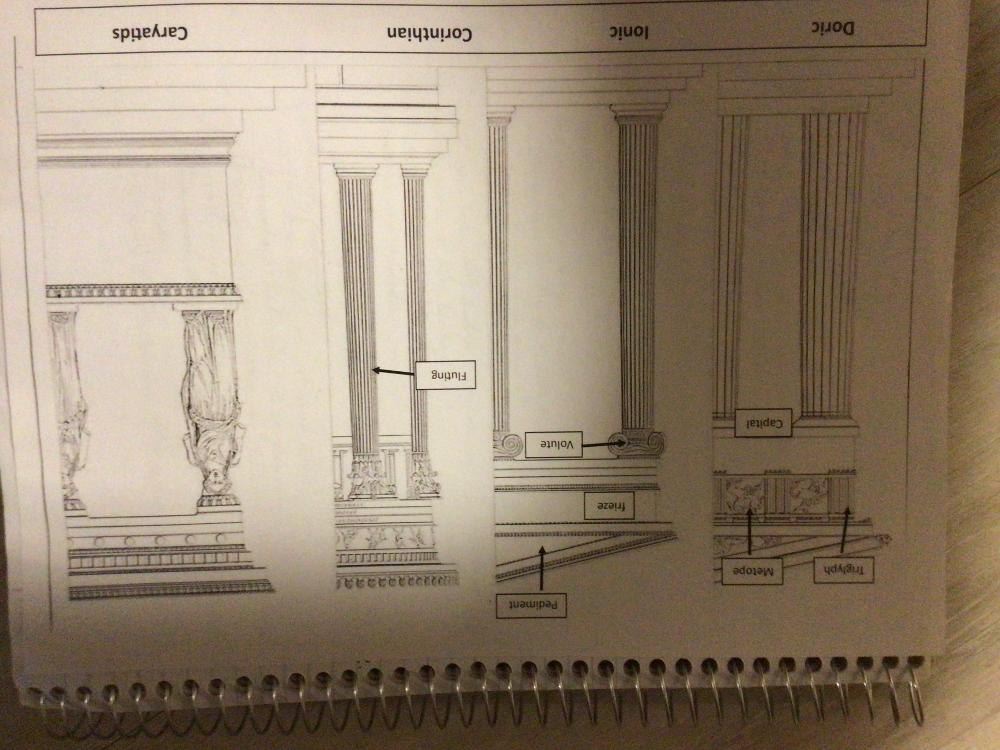
Archaic & Early High Classic Art

-Temple of Hera 1
-Archaic and Early High Classical Greece
-Limestone
-Columns wrap all around the temple, worship outside of temple, elevated non-man made location preferred
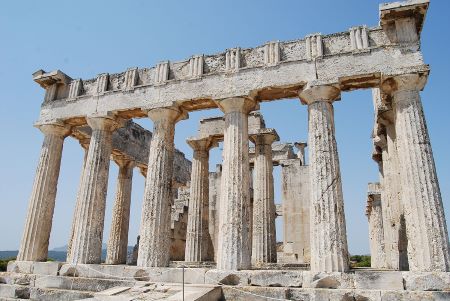
-Temple of Aphaia, Aegina
-Archaic/Classical Ancient Greece
-Stone
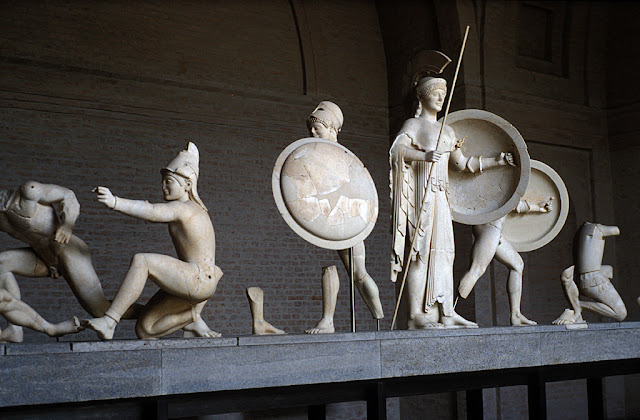
-West Pediment of Temple of Aphaia
-Archaic/Early Classical Greece
-Marble
-Triangular shape, more natural proportions, still stiff, hierarchy of scale, archaic smile

-Dying Warrior from the West Pediment, Temple of Aphaia
-Classical Ancient Greece
-Marble
-Archaic smile, bravery is important, nudity is weakness
What were the three kinds of men shown in Ancient Greek art?
warriors, athletes, and gods

-Dying Warrior on the East pediment, Temple of Aphaia
-Classical Greek Art
-Marble
-No longer smiling, now grimacing, no longer full frontal
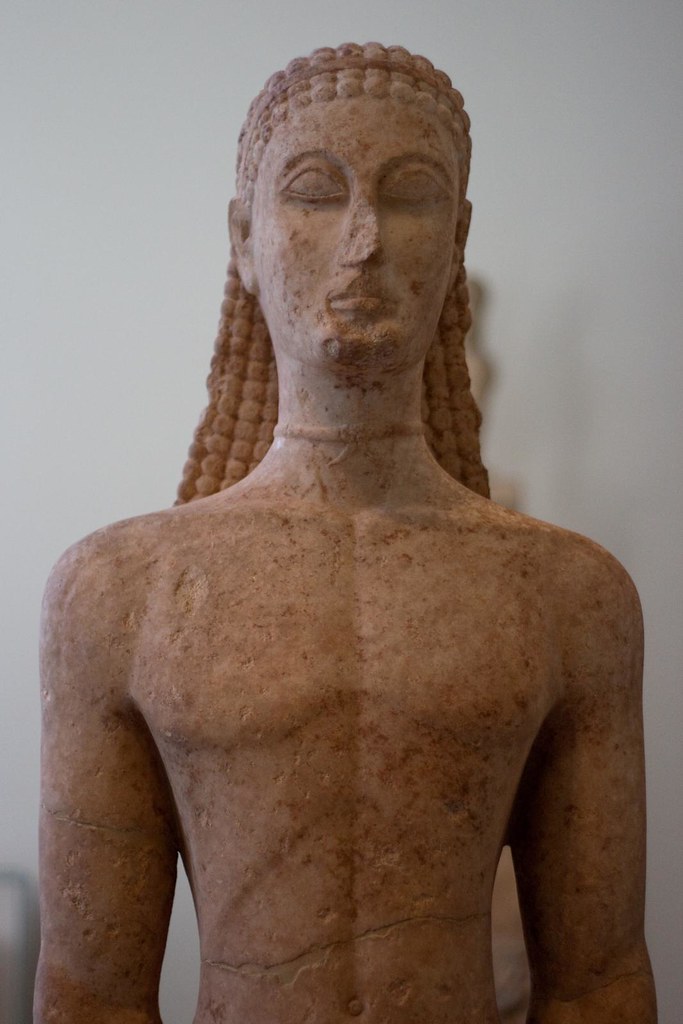
-Metropolitan Kouros
-Classical Ancient Greece
-Marble
-Arm would have been attached at side, one step forward, stylized braids, nude, possibly a votive of Apollo
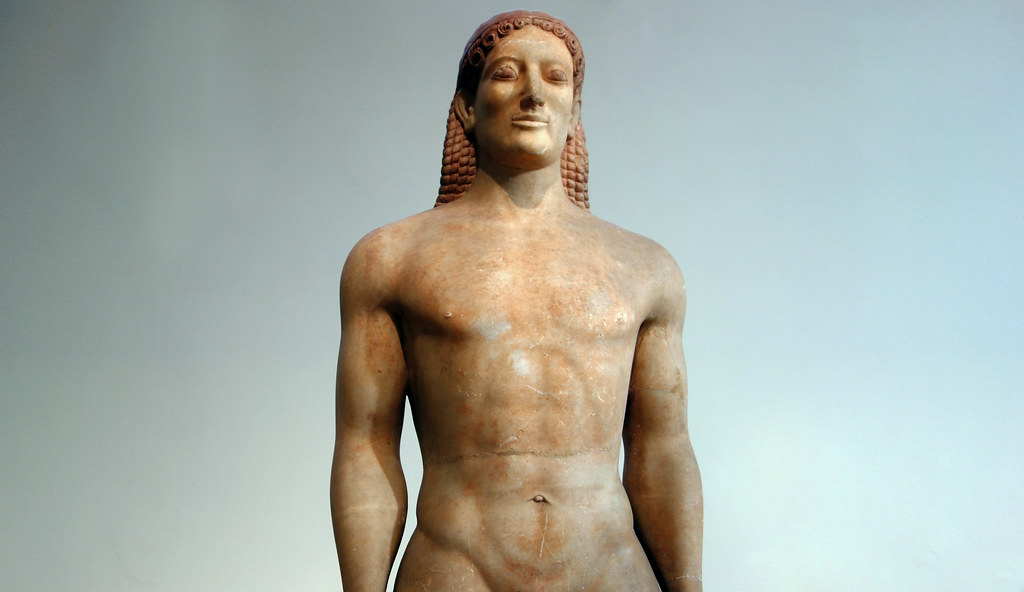
-Anavysos Kouros
-Classical Ancient Greece
-Marble
-Warrior, much more realistic, still partially stylized, has ankles!
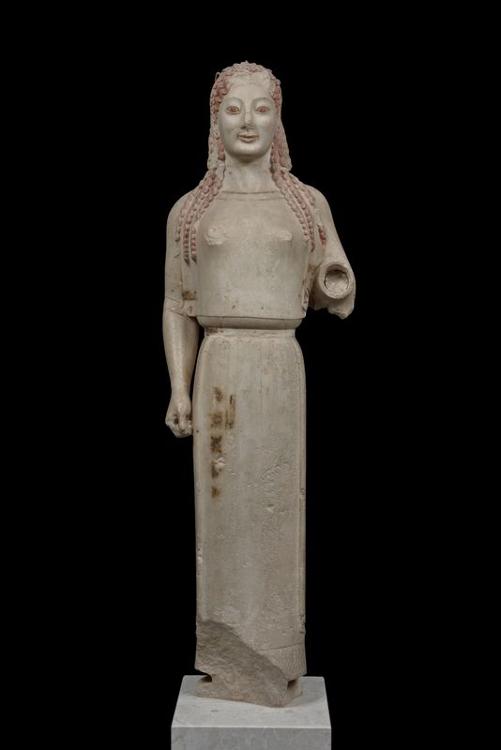
-Peplos Kore
-Classical Ancient Greece
-Marble
-Clothed, possibly Aphrodite, arm broken off as well
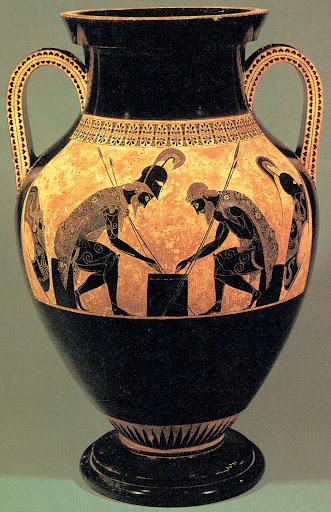
-Achilles and Ajax Playing a Dice Game by Exekias
-Classical Ancient Greece
-Clay, black figure type
-the build up of tension, but during a break in the war, a lot of directional force and the moment of most tension (right before climax), signatures now appear at the bottom of the works of art. base is black, scraped off negative space
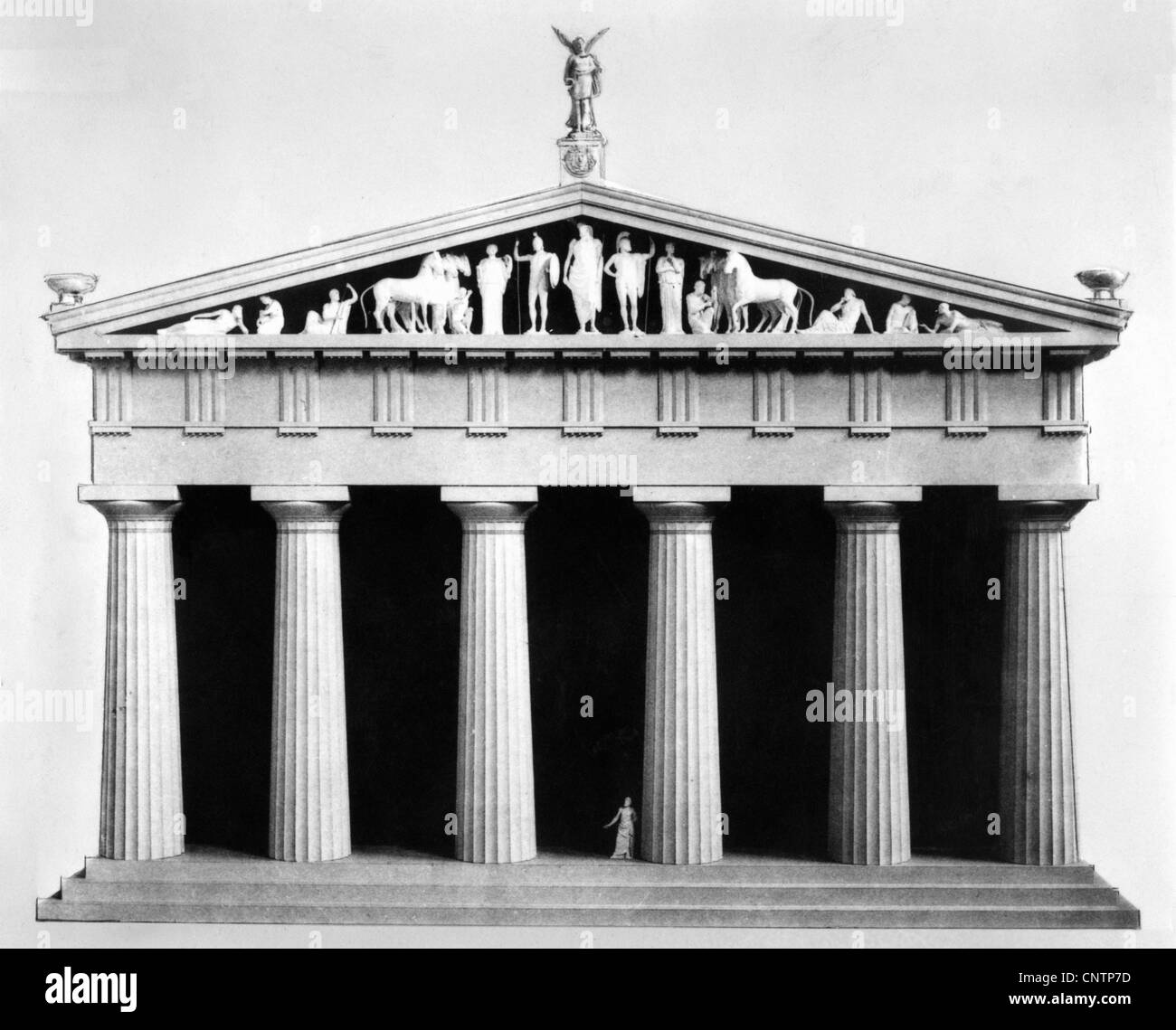
-Libon of Elis, Temple of Zeus
-Classical Ancient Greece
-clay
-drums, earthquake happened
What are the three main concepts of Ancient Greece classical art?
-humanism (focus on what people can do)
-rationalism (order over chaos)
-idealism
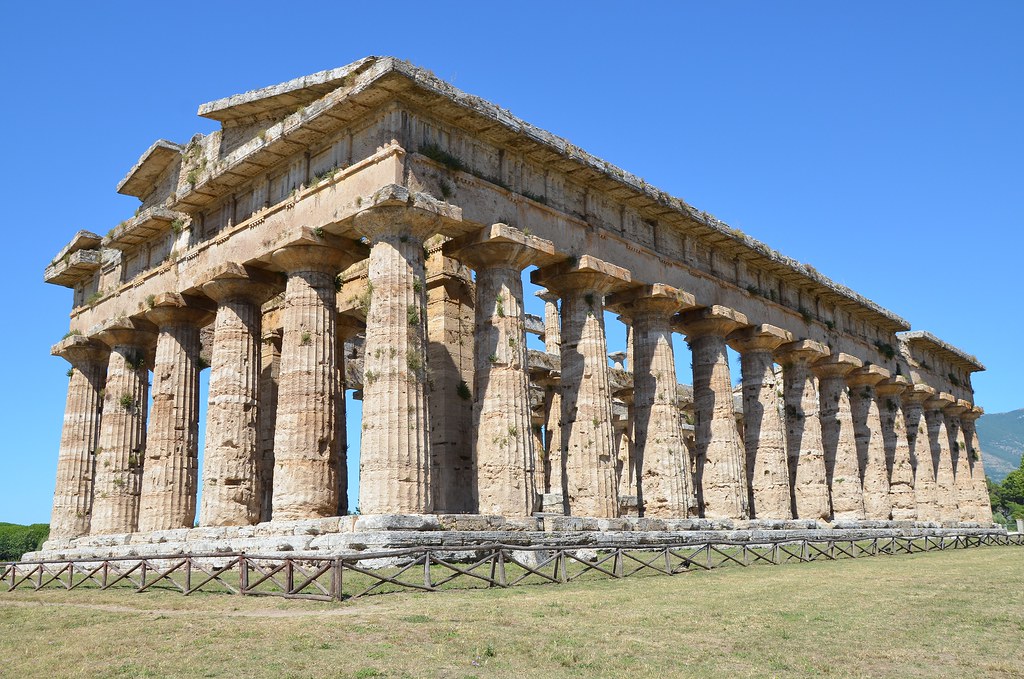
-Temple of Hera II or Apollo, Paestum
-doric column
-Ancient Classical Greece

-Athena, Herakles, and Atlas metope from the Temple of Zeus
-Ancient Classical Greece
-Marble
-Herakles supported by Athena, goes to Atlas to get the golden apples, Atlas tells Herakles he is no longer holding up the world, so Herakles tricks him. No facial expressions, order over chaos, transition between archaic and classical
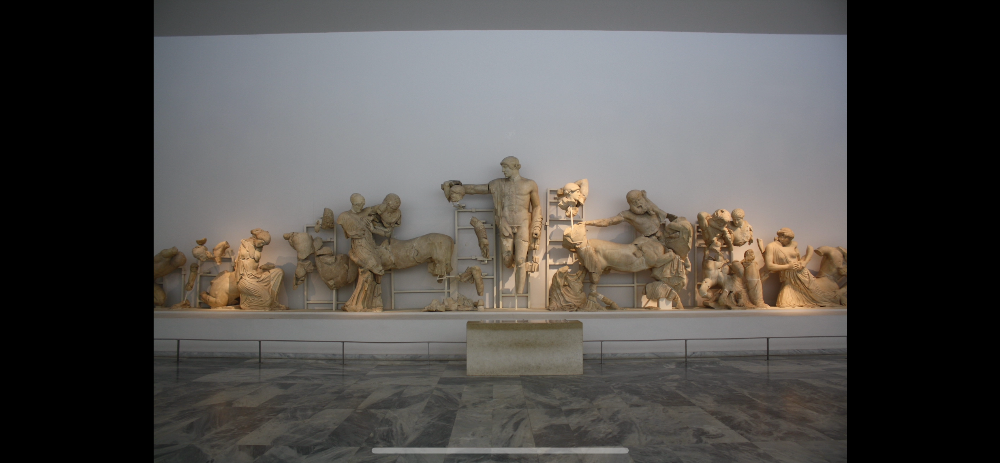
-West Pediment, Temple of Zeus
-Early Ancient Greece
-Marble
-Centaurian, enemies are not idealized, composite creatures
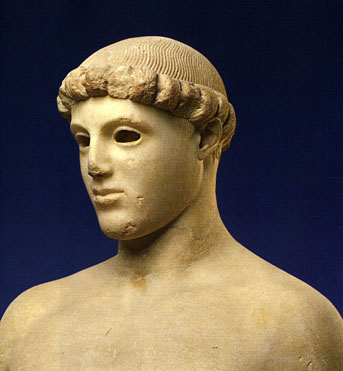
-Kritios Boy
-Early Ancient Greece
-Marble
-more naturalization, first time seeing controposto
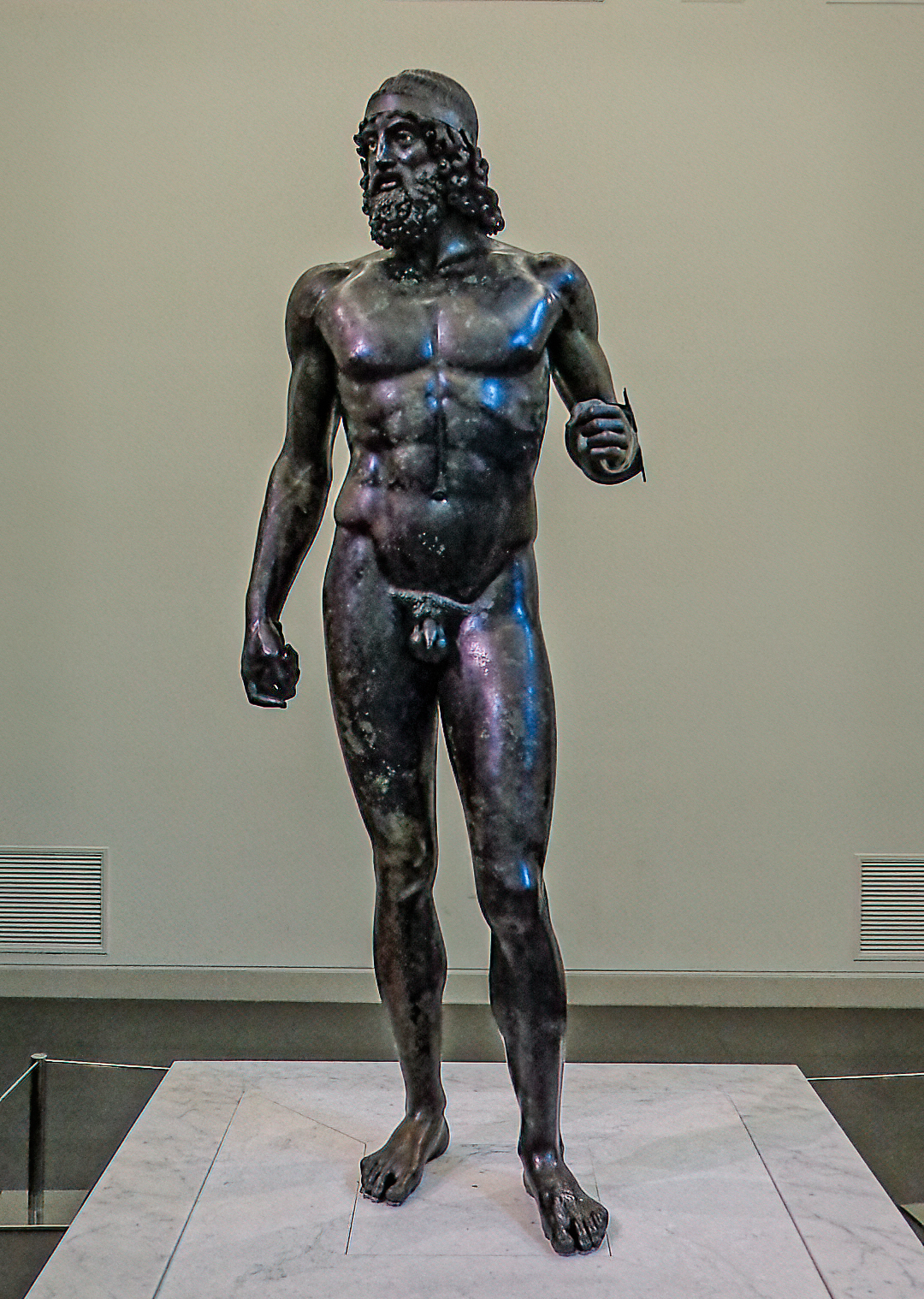
-Warrior from the Sea off Riace, Italy (will most likely be on test)
- Early Ancient Greece
-Bronze
-found in the ocean, would have been a pair, originally had wooden accessories like a shield, nudity in reference to bravery

-A symposium scene from the tomb of the diver
-Early Ancient Greece
-fresco on travertine slab
-women were there for procreation, but they had male lovers and liked to indulge in pleasentries

-Discus Thrower, Myron. Roman copy of a bronze statue
-Ancient Early Greece
-Marble
-Moment of most tension before climax, nude, body creating geometric shapes

-Polykleitos, Spear Bearer (Doryphanos)
-Early Ancient Greece
-Roman copy of a bronze soldier
-Marble
-Controposto, each part is a work of a whole, warrior held shield and spear, no emtion and nude

-The Athenian Acropolis
-Early Ancient Greece
- can be seen from anywhere in Athens
-marble

-Kallikrates and Iktinos, The Parthenon
-Early Ancient Greece
-Marble
-gift to goddess Athena,
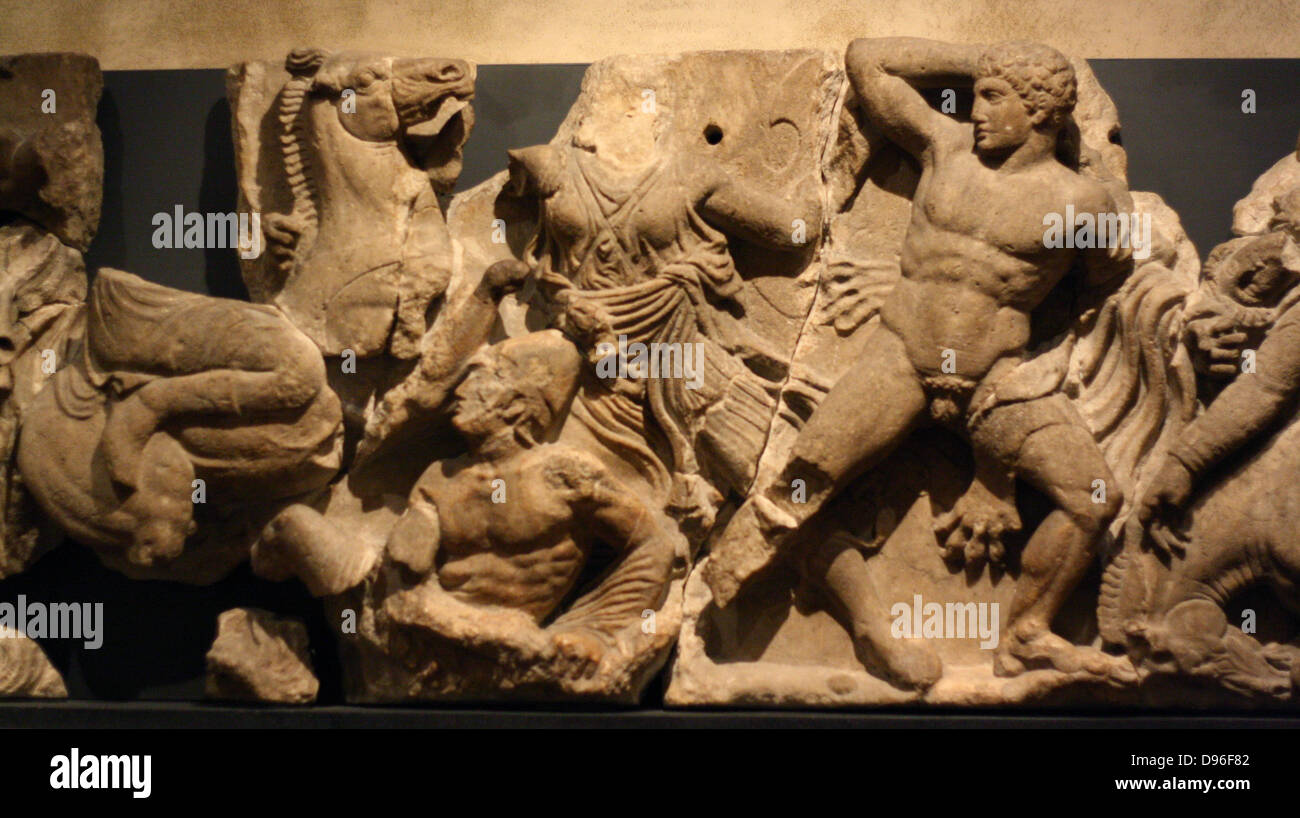
-Lapith Fighting a Centaur
-Early Ancient Greece
-marble

-Young Women and Man from the Procession
-Early Ancient Greece
-marble
first time we see the general, nameless, people of Athens on a religious temple

-Phidias, Athena, and Parthenos
-Early Ancient Greece
-gold, ivory, and wooden core
-remade multiple times

-The Erectheion
-Early Ancient Greece
-Marble
-on one side, ionic, on porch there were maidens, replaced columns with women in controposto

-Porch of the Maidens, south side
-Early Ancient Greece
-Marble
-Antithesis of pantheon because asymmetrical, decorated exterior lavishly
-PARTHENON IS ONLY TEMPLE TO IDENTIFY
What are the differences between the east and west pediment statues?
-east is dying warrior in pain, west is dying warrior with archaic smile
The Acropolis
-The Athenian Acropolis
-Early Ancient Greece
-many cities have an acropolis (high city), Delian league (all city states give money for war to Athens, Herakles takes all the money and rebuilds the acropolis which pissed off Athens
What is the division of early and late ancient Greece?
-Peloponnesus War of Sparta vs Athens.
-plague breaks out, sparta wins bc of this, then goes to war with macedonia and loses.
-Alexander the Great takes over, reached India and overtook Egypt, when he dies that is technically the start of late ancient/hellenistic period
-greek roman history crash course
-early: winning more wars, more idealized and clothed and peaceful, moment before climax.
Late: doing worse in general, wars disease and bad things, their art had more drama and action and emotion and sexuality, defeat instead of just victory, women were more often nude. they had dignity for their enemies
both: composite creatures as monsters, men mostly nude, largely athletes, soliders, and gods
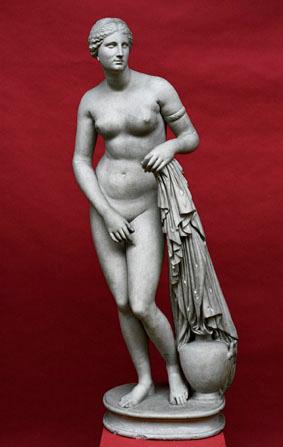
-Aphrodite of Knidos, by Praxiteles
-Late Ancient Greece
-Marble
-Nude, goddess about to bathe
-Rationality and order over chaos, still perfect proportions but more worldly, modest but draws eyes to modesty

-Hermes and the Infant Dionysis by Praxiteles
-Late Ancient Greece
-Marble
-Zeus has many kids bc he's a slut, idealized and stoic, s-curve controposto which is huge with this artist

-Weary Herakles by Lypsippos
-roman copy of a bronze original
-demigod, 12 labors, tired body posture, psychological exploration
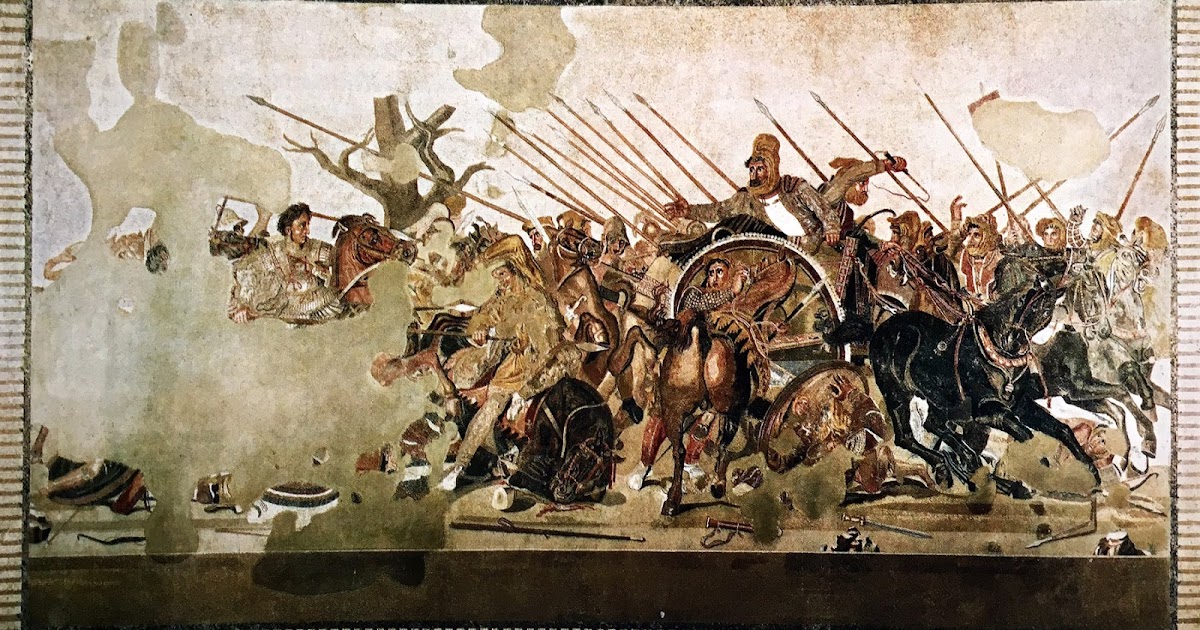
-Battle of Issus by Philoxeros of Eretria
-Late Ancient Greece
-Roman copy mosaic
-Darius fled from Alex the Great, now showing the action instead of the moment before
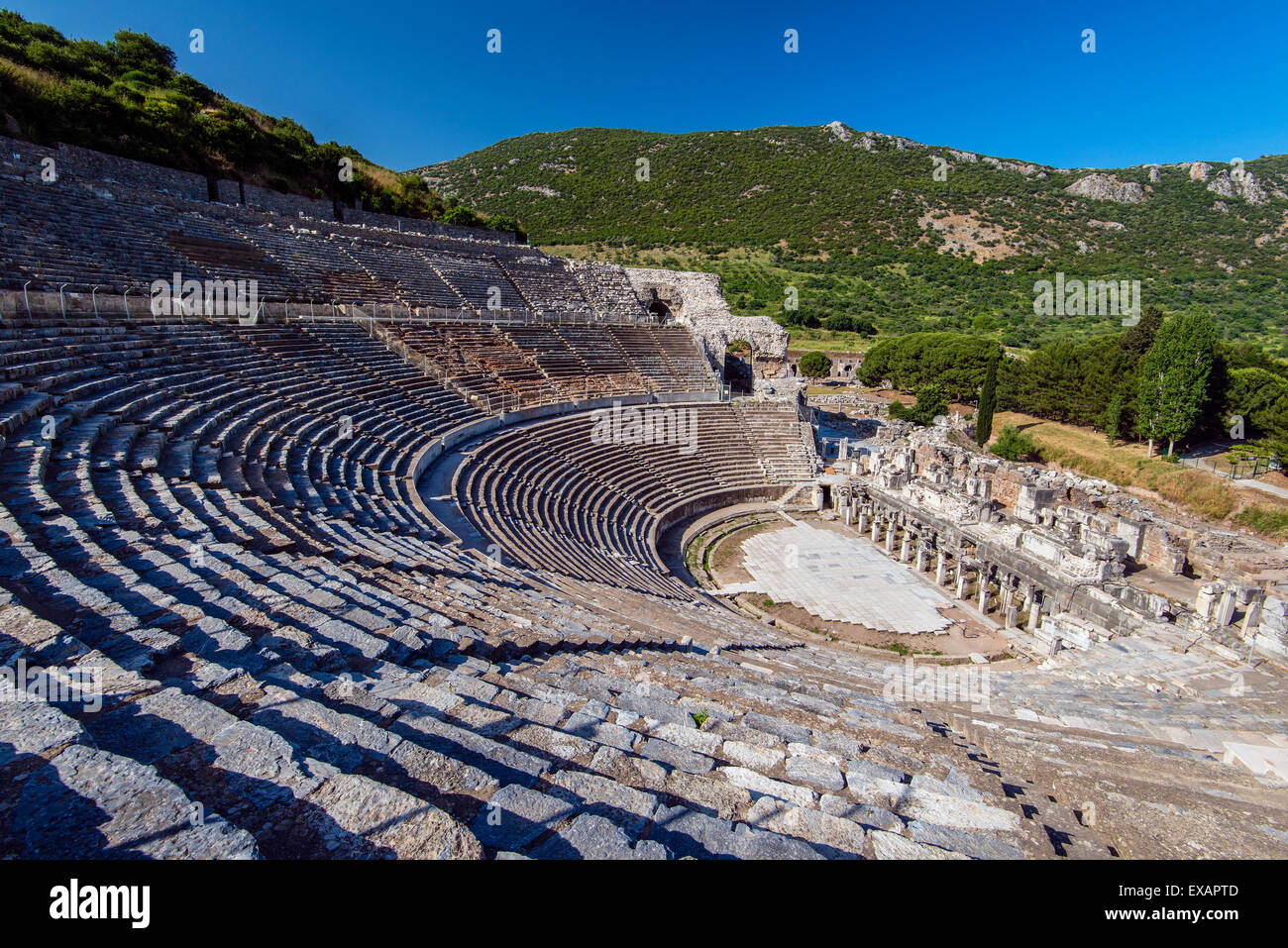
-Polykleitos the Younger, Epidauros Theater
-Late Ancient Greece
-stone
-late greece is all about death, war, and drama, would've been for religious plays, emi-circle, cut into hillside. STARRED
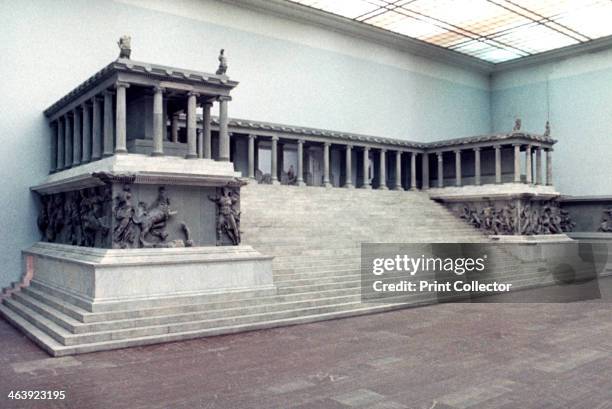
-Reconstructed west front of the Altar of Zeus
-Late Ancient Greece
-Stone
-Freize has over 100 depictions

-Athena battling Alkyonos, detail of gigantomachy frieze, altar of Zeus
-Late ancient Greece
-Marble
-Nike placing laurel wreath onto Athena's head. drama
-sculptures now playing with light for drama

-Dying Gaul by Epigonos
-Late Ancient Greece
-Roman copy of a greek original, marble
-Wounded, on shield, not an old and ugly monster, but rather an idealized enemy to depict dignity. STARRED
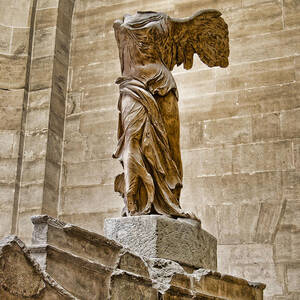
-Nike alighting on a worship
-Late Ancient Greece
-marble
-landing with wings open, moving cloth, like a living and breathing animated statue
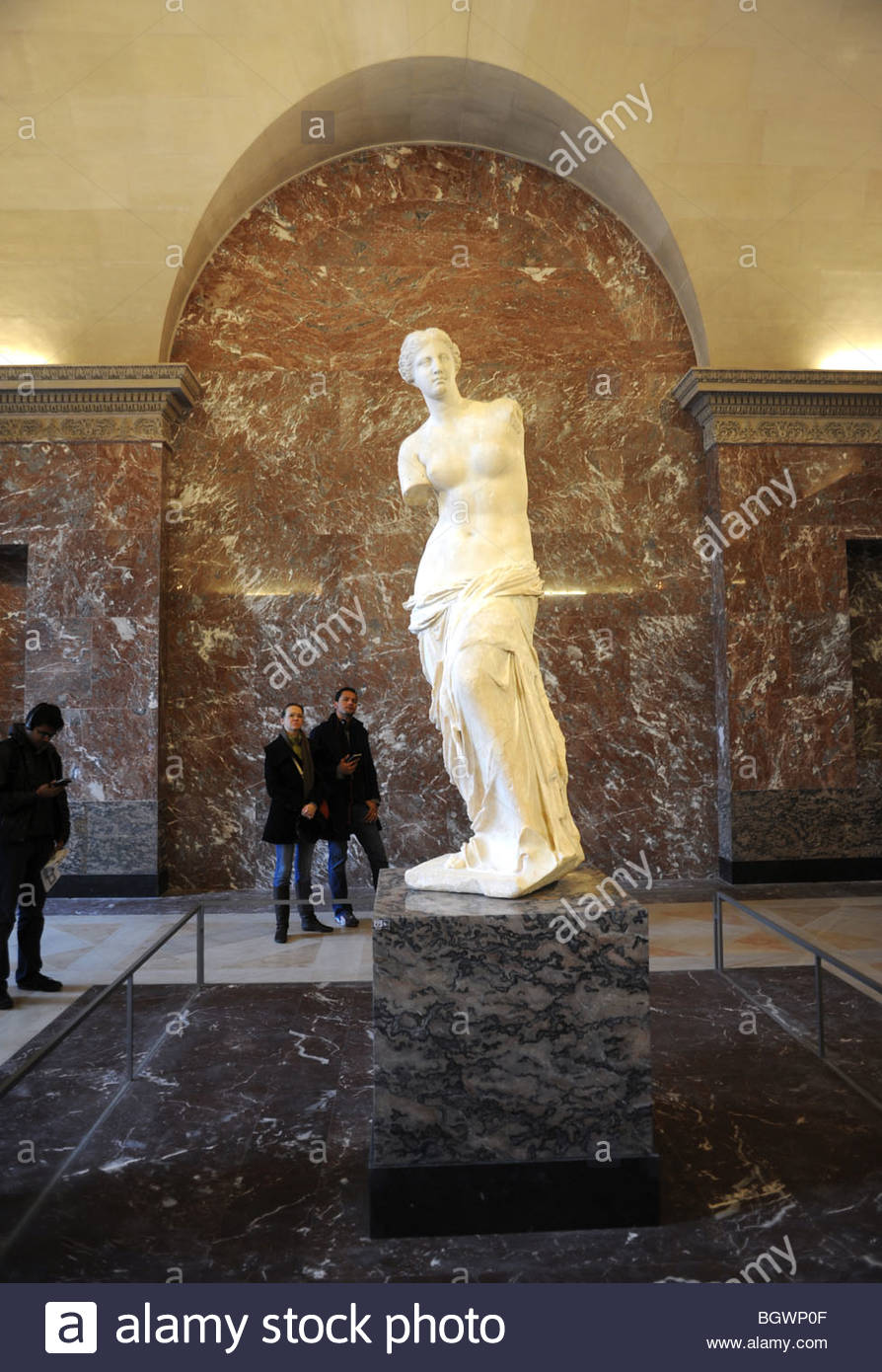
-Aphrodite (Venus de Milo) by Alexandros of Antioch on the Meander
-Late Ancient Greece
-marble
-stoic face, downright sexually naked, disrobbing
-more pronounced s-curve, human entity, votive offering
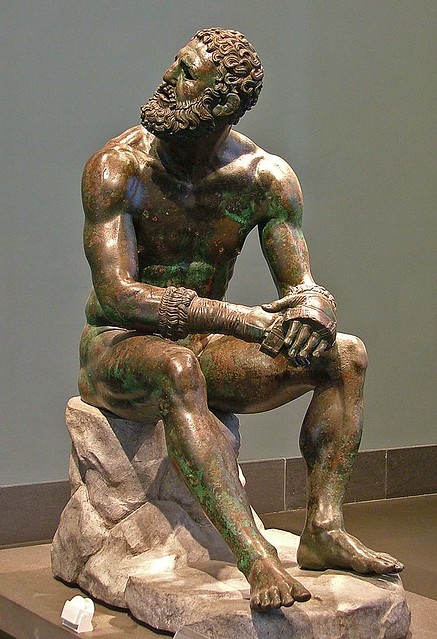
-Seated Boxer
-Late Ancient Greece
-bronze
-Not hierarchy seating, but seated because he isn't in a moment of tension or climax. tired, depicting different aspects of life, not just victories
Name the differences between early and late ancient greek art
-Early: reason/order/humanity, tension before action, archaic smile and stoicism, women not nude, ugly and crude enemy, winning wars, and doric orders
-Both: composite, centaurs as monsters, women were priests or goddesses, Athletes gods or warriors, men are nude, controposto
-Late: drama/action, more emotions women are nude, dignity for enemies, ionic orders
What are the differences between Etruscans and Greek Temples
-similar to doric order, but columns and roofs are made of wood and walls are mudbrick, stone base, terracotta statues in etruscan
-greek temples were fully symmetrical and etruscan only had columns in front, marble
-etruscan, different diety in each room
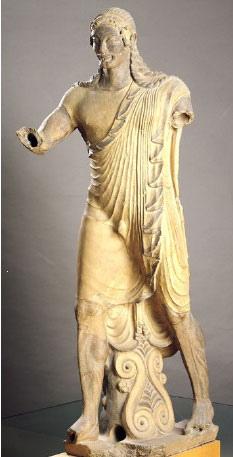
-Apulu
-Etruscan art
-Painted terracotta
-similar to archaic smile, v frontal like Kouros, different bc of clothing, he's actually moving, more realistic
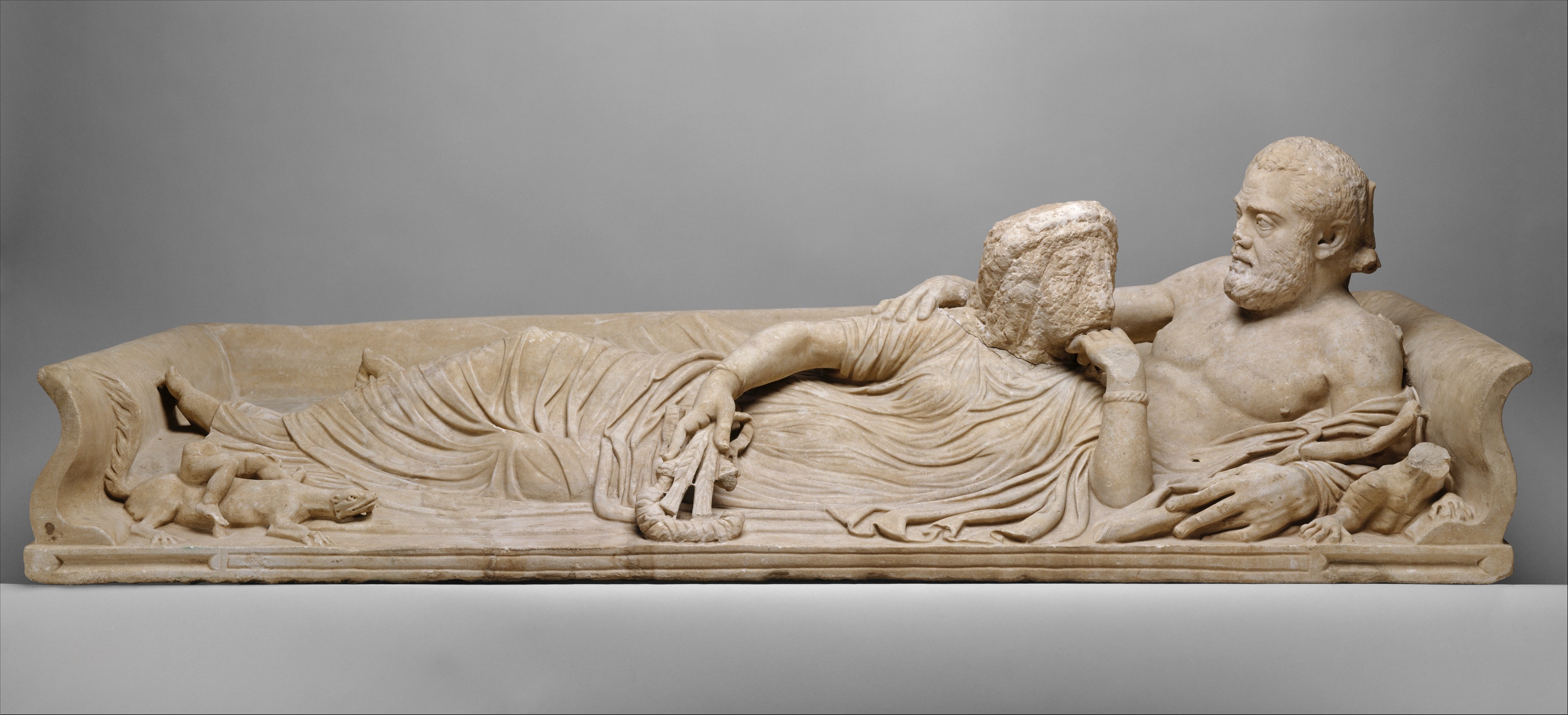
-Sarcophagus w/ reclining couple
-Etruscan art
-painted terracotta
-also cremated, but if wealthy, would commission a sarcophagus. Ancient greece had symposiums, but now women could attend events and banquets, not a true portrait, almond shaped eyes and dreaded hair
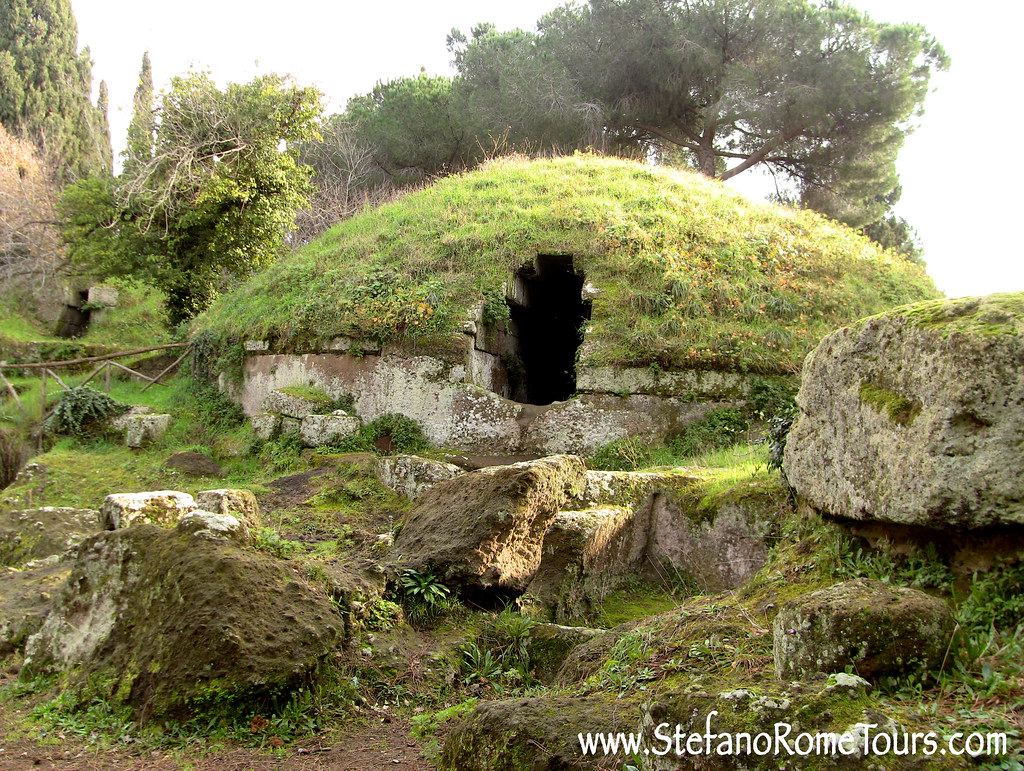
-Tumuli in the Banditacci necropolis
-Etrsucan art
-kept dead in specific areas like a graveyard bc of water poisoning and religion

-Interior of the tomb of the Augurus
-Etruscan
-false door symbolism into afterlife, mourning games, Augur is the official. symbolism of birds being close to heavens, weeping child and chair for official. Image of a soldier with a prisoner being brought out for games like naked wrestling
-only wealthiest would have them

-Interior of the tomb of the leopards
-Etruscan
-banquet social scene, women depicted as lighter than men. twisted view
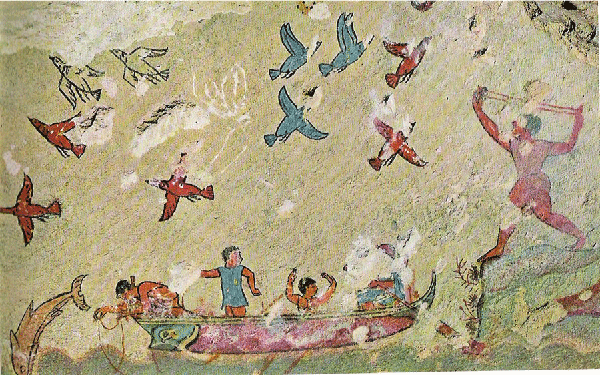
-Diving and Fishing
-Etruscan
-fresco
-bird symbolism, diver going into new life, depicting what they like to do in life and afterlife

-Chimara of Arezcco
-Etruscan
-bronze
- composite creature monster, head of lion and goat, serpent tail, shown malnourished and weak, still fighting, votive offering
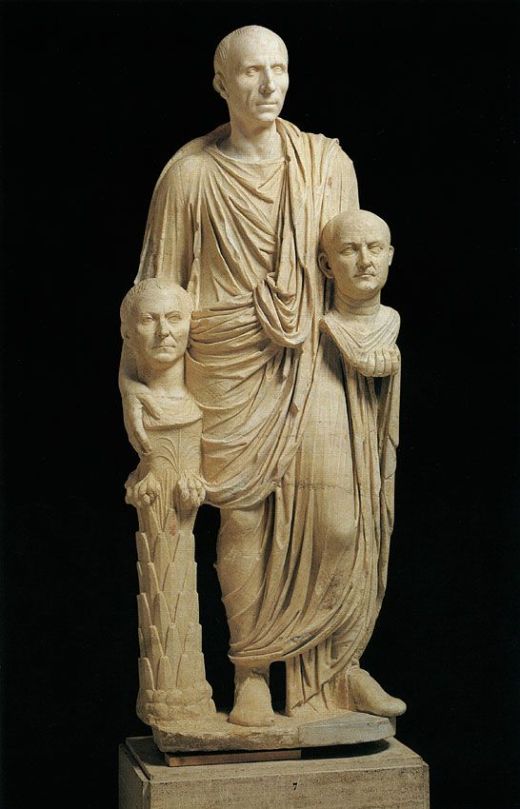
-Patrician with Portrait Bust of Two Ancestors
-Roman Republic
-marble
-Being old is a huge importance in art (veristic), body was premade, then portrait head would be added, shows citizenship of generations which was a flex

-Portrait of a Roman General
-Roman Republic
-marble
-general, armor next to him, drapery=important member of society, ideal figure but old face/veristic

-Demarius w/ Portrait of Julius Caesar
-Roman Republic
-silver
-1st time seeing a non-diety on a coin, coins promote those in rule, portraiture but as a political statement, shown as older in this one
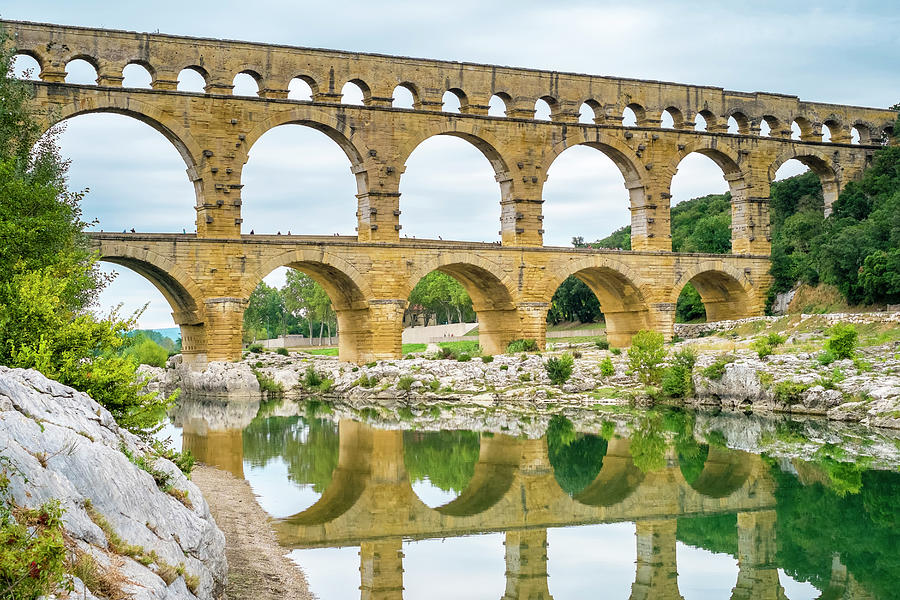
-Pont Du Gard
-Roman Republic
-brick, aquaduct
-brings clean water elsewhere
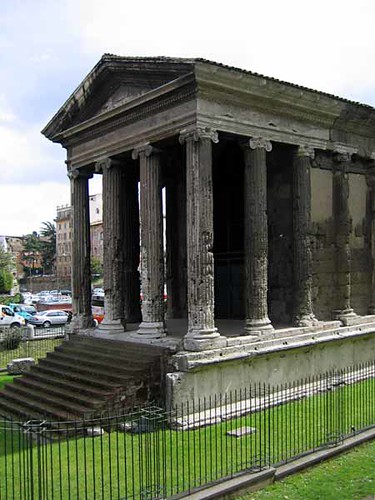
-Temple of Portunus (Temple of Fortuna)
-Roman Replublic
-Stone
-small, engaged columns in the back, no pediment sculptures
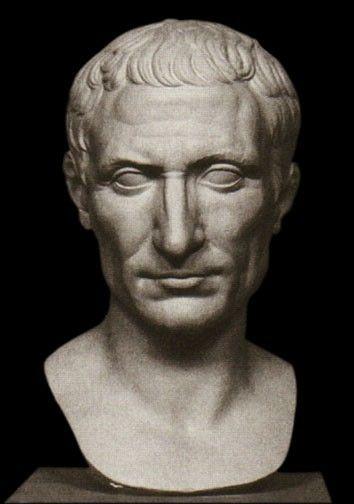
-Portrait of Julius Caesar
-Roman Republic
-marble
-veristic, bust, stoic but not emotionless, declared himself as a dictator so the government stabbed him and created a civil war
What was the government system like in Early Ancient Rome?
-Similar to the republic; counsel, commander in chief, chief priest, and senate of elders. Octavius was all of these

-Portrait of Augustus as General
-Early Roman Empire
-Marble
-Baby Ero at leg so Augustus could claim a familial connection to the gods. Maintains peace and prosperity. Augustus was depicted as many different things to represent that he is for the people and he wanted them to like him (all roman art is propaganda)
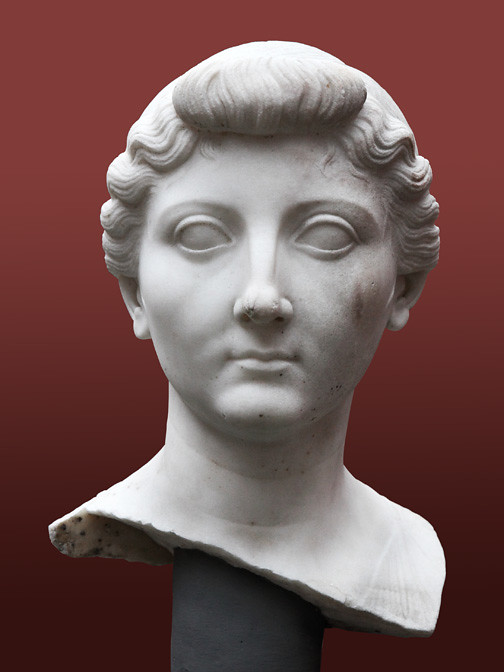
-Portrait Bust of Livia
-Early Roman Empire
-Marble
-wife of Augustus, youthful instead of versitic, their sculptures never age while they do, symbolism of godliness. women are still less than, unlike etrsucans

-Ara Pacis Augustae (Altar of Augustan Peace) and Procession of the Imperial Family
-Early Roman Empire
-Stone, Marble
-Panels depict godliness, on alter is a procession of the royal family, inspired by the frieze from the Parthenon. Depicting political reign, children actually look like children--at the time there was a declining fertility rate so the gov incentivized people
What was the impact of concrete in Roman society?
ADD PICTURES OF VAULTING
-Concrete was used to build roads, create true arches with keystones on top.
-True arch tunnel=barrel vault and buttressing (added pillars for support)
-Groin=cross section X where barrel vault meets even stronger structure
-Dome, occulus center opens to sky
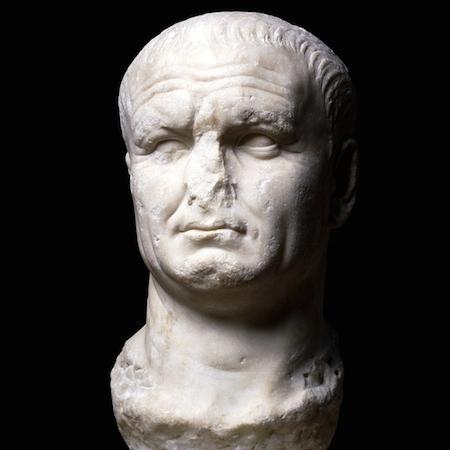
-Portrait of Vespacian
-Early Roman Empire
-Marble
-unpretentious, wants to distance from Nero's misrule, veristic true portrait
-Young Flavian Woman
-Early Roman Empire
-Marble
-first time seeing beauty for beauty's sake, still political bc we can see fashion trends
-Middle-Aged Flavian Woman
-Early Roman Empire
-Marble
-old again but not idealized, respectful, age=virtue
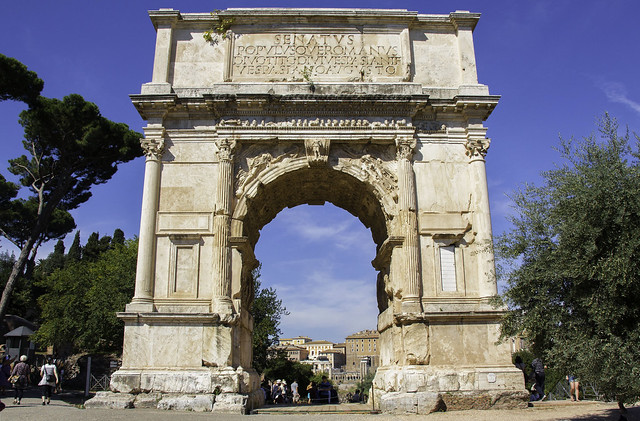
-Arch of Titus
-Early Roman Empire
-Stone
-Victory arch, art as a gateway and a celebration of almost anything (like building a new road)

-Spoils of Jerusalem, Arch of Titus
-Early Roman Empire
-Marble
-Naturalistic, ancient Greek inspo, carrying menorah, deeply carved to create depth and play with lighting. STARRED
What are the differences between a Greek Theater and a Roman Ampitheater?
Greek:
-plays were religious, carved into natural hillside, only a semi-circle
Roman:
-for sport and entertainment, made into manmade mountain with concrete, completely enclosed

-Colosseum
-Early Roman Empire
-Concrete
-Gladiators, purchased slaves that were trained to fight. Not killed bc they cost money to train, corporal punishment like prisons, not pitted against animals in the trad way we were taught
-trapdoors, flooding colosseum, anyone could go to an ampitheater but they had to sit according to their ranking in society
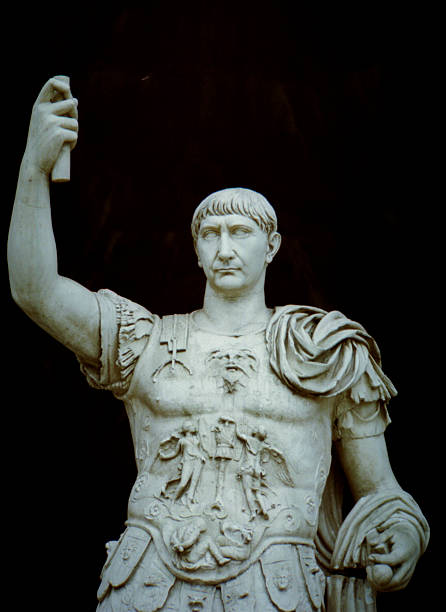
-Trajan
-High Roman Empire
-Marble
-nude bust, heroic, not idealized youth or old. made colonies for elderly war vets and commissioned several large public buildings
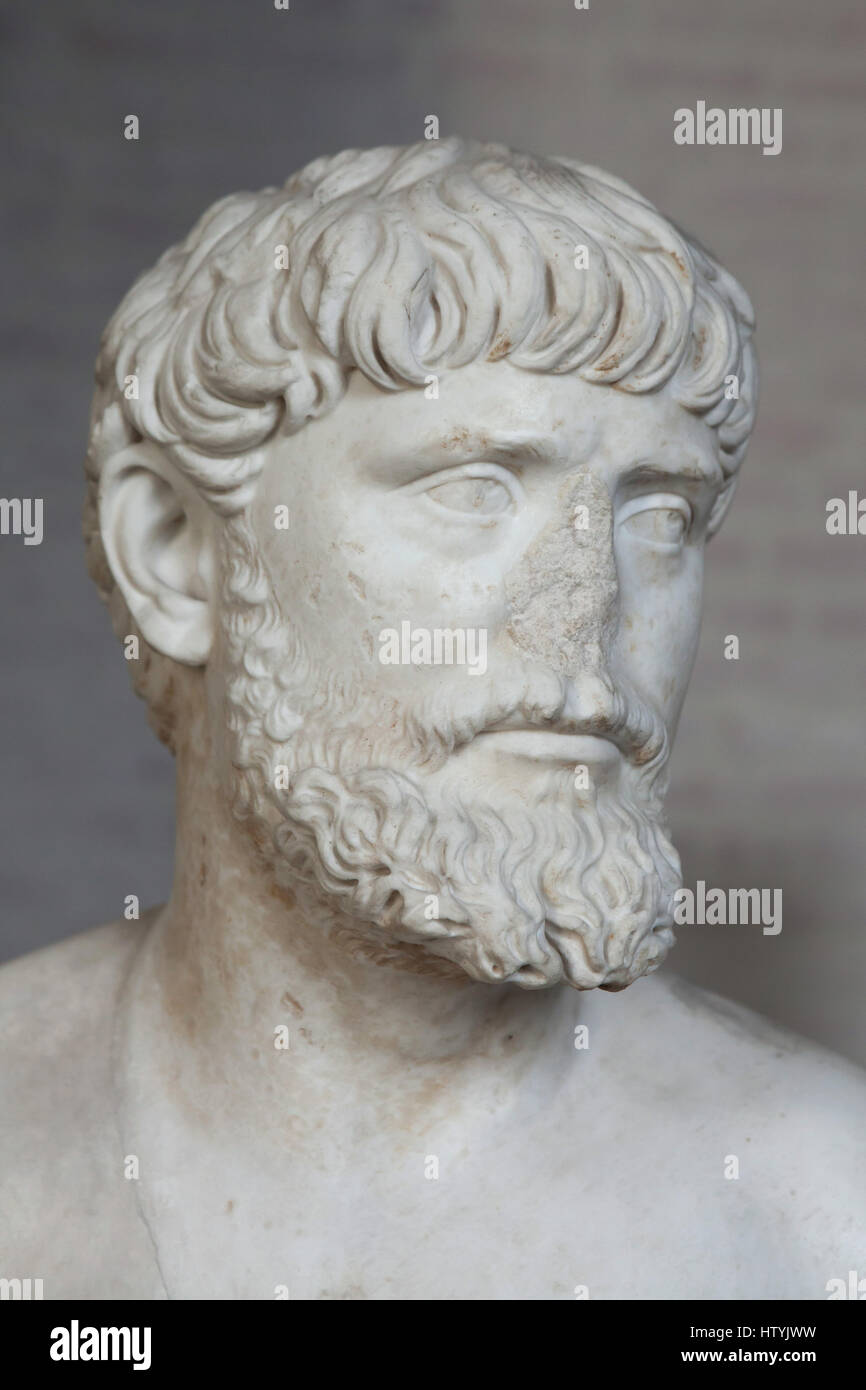
-Apollodorus of Damascus
-High Roman Empire
-Stone and timber
-forum of Trajan
-bisilica (public courthouse with a central nave and side aisles, zaxis at other end. Secular space, legal and social matters. Light enters through clerestory windows
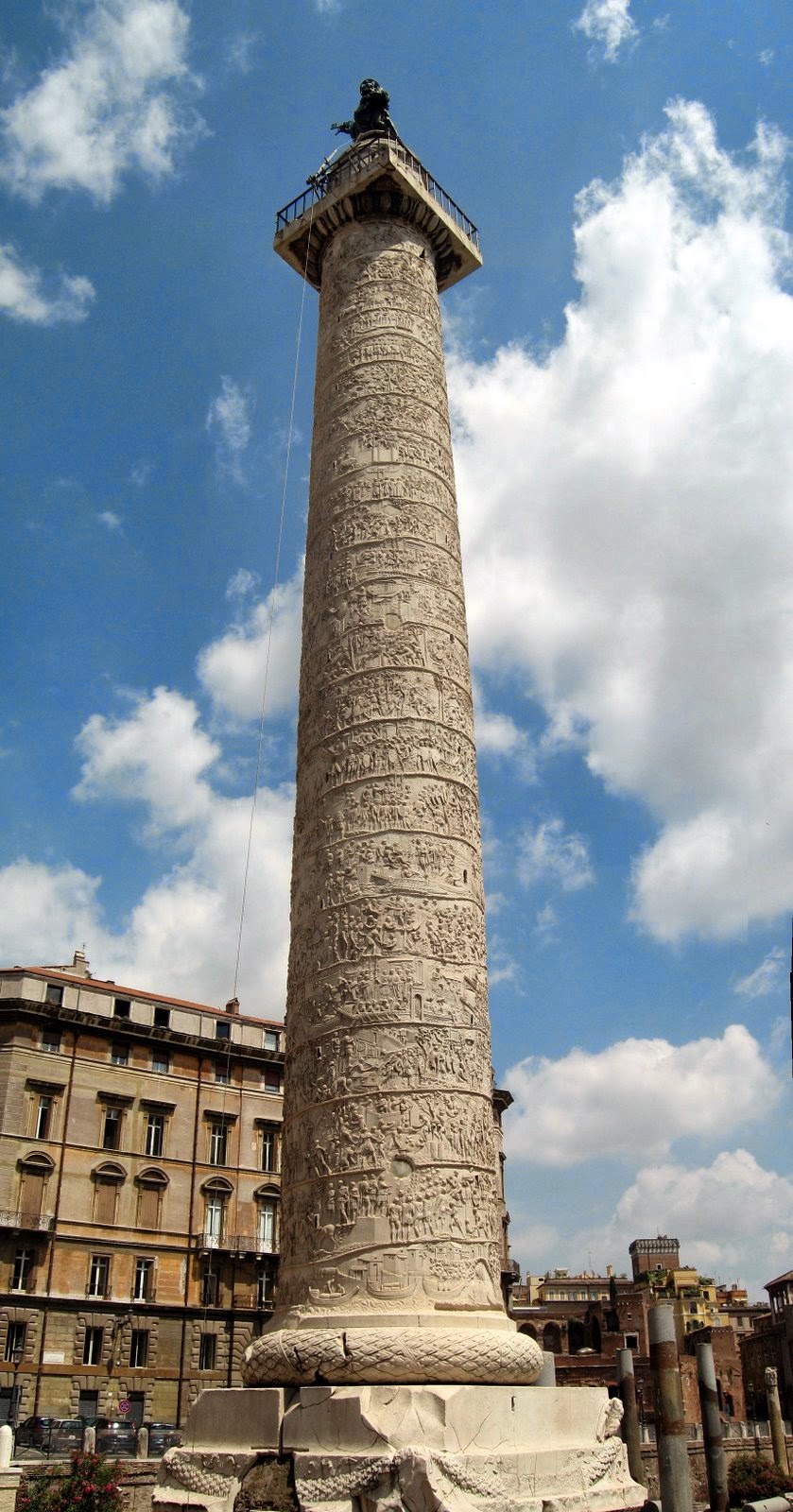
-Column of Trajan
-High Roman Empire
-Marble
-Sat between bisilica and temple. St.Peter on top. Continuous spiral frieze that shows all of the battle scenes Trajan won (through strategy instead of just numbers). Pedestal serves as tomb STARRED
Markets of Damascus
-Markets of Demascus, Apollodorus of Damascus
-High Roman Empire
-concrete
-like a shopping mall that overlooked the forum, sequence of groin vaults

-Portrait Bust of Hadrian
-High Roman Empire
-marble
-he starts a beard trend in emperors. Architect, author, hunter, mature but not old. STARRED
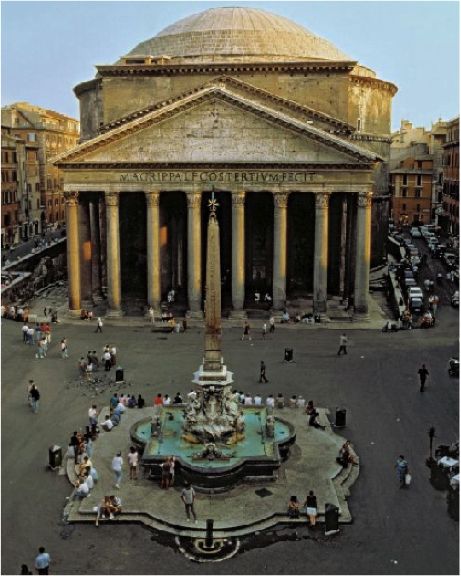
-Pantheon
-High Roman Empire
-concrete
-built under Hadrian's rule, place to worship to many gods. Columns only in the front, epitome of roman art/architecture, dedicated t Mars, Venus, and Julius Caesar. Dome representing sphere/the world. occulus to represent heaven and drama, basalt for base, marble veneer, pumice top. STARRED

-Hadrian's Villa by Canopus & Serapeum
-High Roman Empire
-Marble
-pumpkin shape, dome grotto, like greek art but breaking a few rules

-Equestrian statue of Marcus Aurelius
-High Roman Art
-bronze
=aurator stance, weary face, wrote about his struggles, his reign is the beginning of classical art. STARRED
-one of the first emperors to show concern and weariness
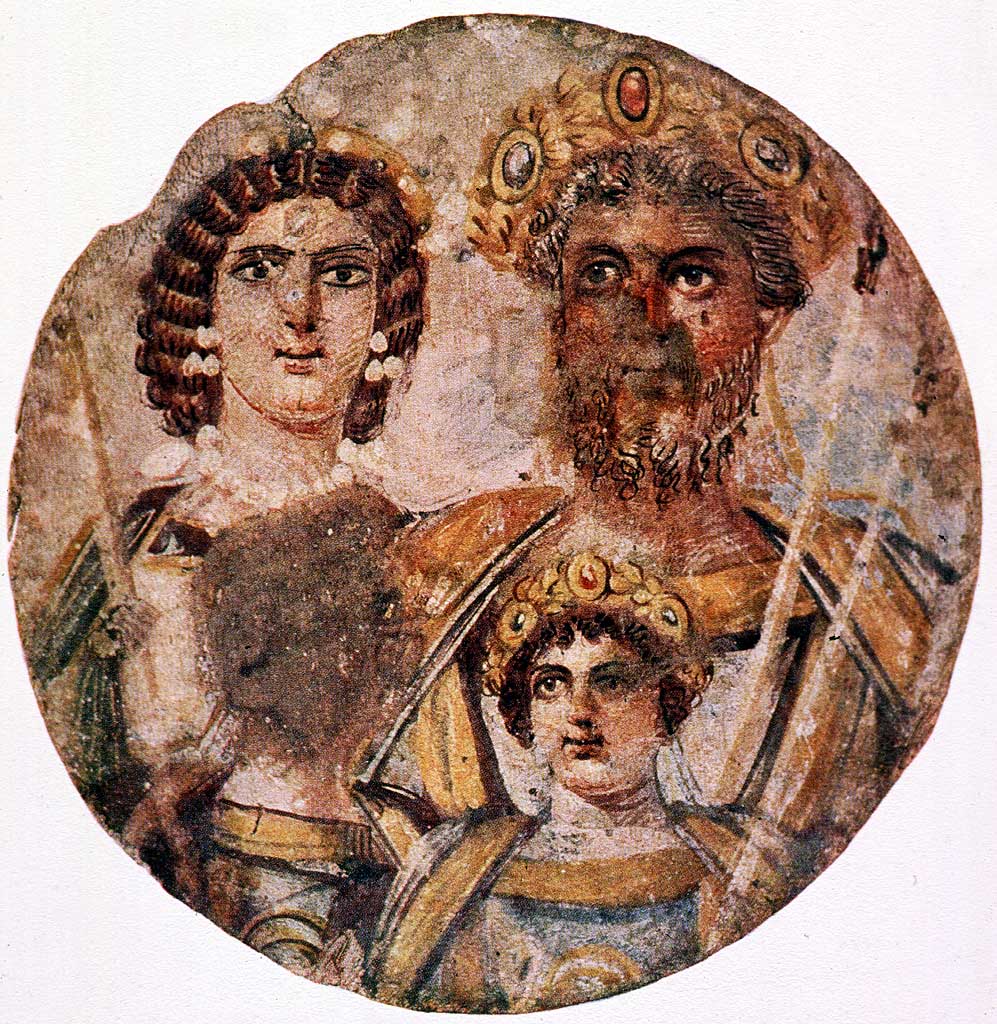
-Painted Portrait of Septimus Severus and his family from Egypt
-Late Roman Empire
-Tempera on wood
-Paganism starts losing ground slow change to monotheism, adopts himself to Marcus Aurelius after civil war for legitimacy to throne
-roman power begins to wane, economy declining, ppl challenging control/authority of rome, religion changing

-Bust of Caracalla
-Late Roman Empire
-marble
-had wife murdered, one son of Severus, bravery in nudity with a status cape. Not weary, furrowed brows, v different from the friendly augustus, started hair trend, cape equals status

-Baths of Caracalla
-Late Roman Empire
-marble
-intense expression, murdered on the 6th round of emperors. active builder (the baths that had multiple different temperatures and purposes, but bacteria and infections as well)

-Portrait of Four Tetrants
-Late Roman Empire
-purple marble
-Diacletions tries to share power (split empire four rulers, falls apart but east and west still stay split) with maximinian to save himself from assassination. civil war resumes later, not nearly as naturalistic, shortened, almost look identical, trust to share power, but still hesitant, each ruler had one hand holding the hand of another and the other hand on their sword

-Arch of Constantine
-Late Roman Empire
-concrete and marble
-3 arches which is different from early empire. Constantine ended issues of Milach (christian persecution). moves east to make new Rome (Constantinopal), things taken from other monumets
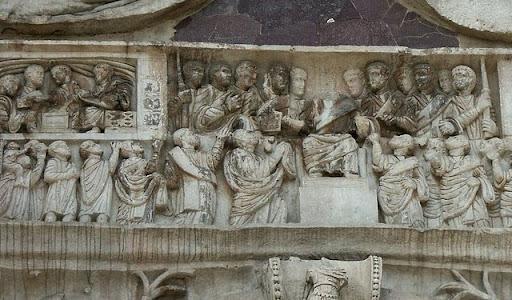
-Distribution of Langesse, Arch of Constantine
-Late Roman Empire
-marble
-return to hierarchy of scale, very flat. giving people something out of charity

-Basilica Nova
-Late Roman Empire
-brick and concrete
-coffered ceilings (weight distribution), restated cutaway view in a secular, public place, clerestory windows, naves (center) aisles on sides, apse where ruler or sculpture would sit
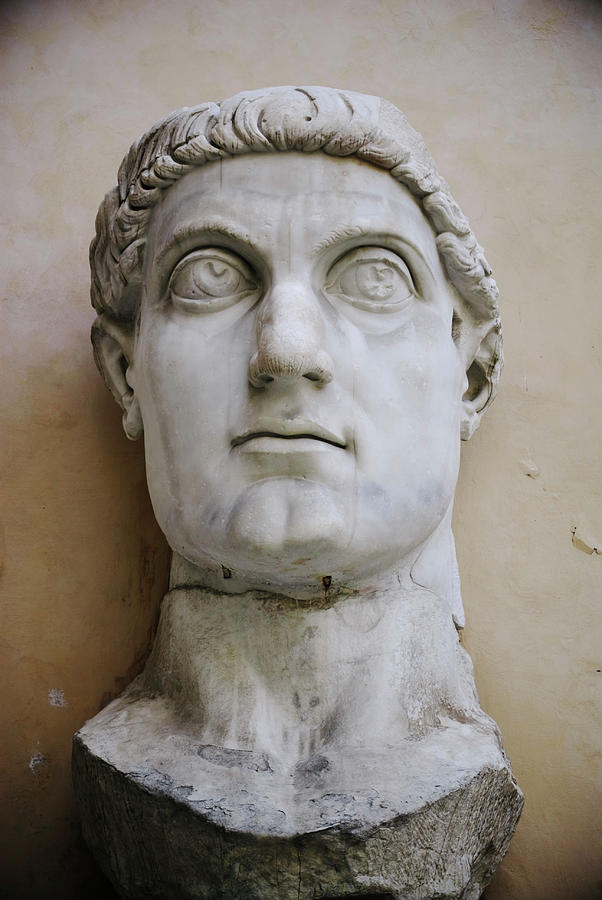
-Colossal Head of Constantine
-Late Roman Empire
-marble
-very roman with the hooked nose, in basilica nova, stylized, bigger=less face details. wooden torso, then bronze cast, then marble final outing
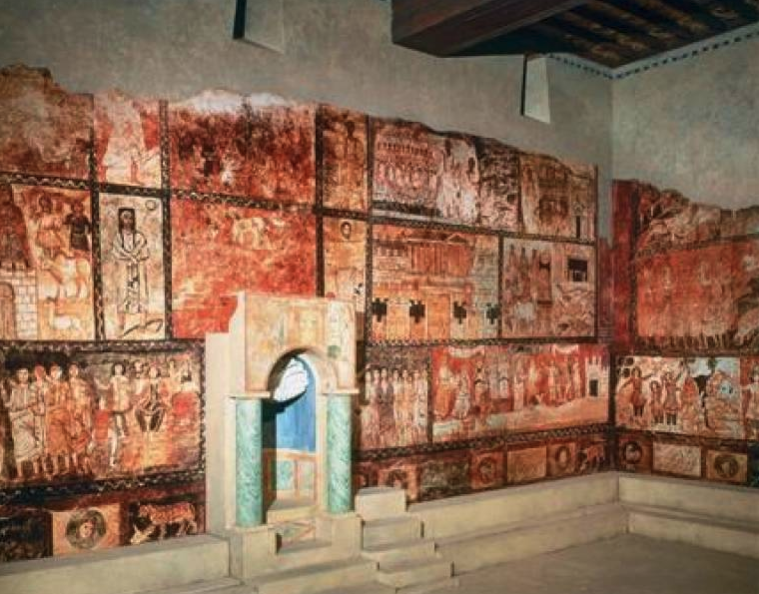
-Dura-Europas Synagogue
-Early Jewish Art
-tempera on plaster
-Jewish house of worship

-The Crossings of the Red Sea, detail of Dura
-Early Jewish Art
-Tempera on plaster
-Won't see god during this time, but will see his hands. lots of flattening, hierarchy of scale, wearing Roman clothing, purple for royalty
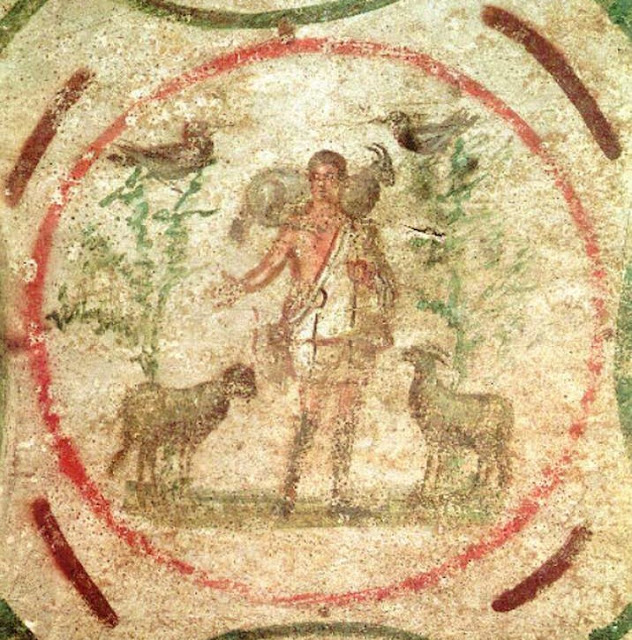
-The Good Shepherd
-Early Christian Art
-Fresco
-under paganism, gods are petty, angry, vengeful, and used for propaganda, whereas this shows that god is good. Images of Apollo in center, disk of sunlight/halo around Jesus, reminder of his promise to lay down his life for the people and their sins.

-Christ as the Good Shepherd
-Early Christian Art
-Marble
-Similar to Roman art, to avoid persecution art style changes. Youth, adolescence not to punish but to take care of.

-Plan of Old Saint Peter's Bisilica
-Early Christian Art
-Architecture, nave, aisles, apse with an altar inside (inside worship now)
What are some of the key differences in eras?
-Roman Republic: ancient pompier Herculean, Caesar, focus on age and ancestors, Ancient Greek influence
-High Empire: colosseum, pantheon, Augustus, pox romana, Hadrian, Trajan. People empire, focus on public spaces (baths, temples, and ampitheater)
-Late Roman: warrior generals that kill each other (murdered brother), tetrarchy, Constanine (edict of Milan took away Christian persecution), split of East and West

-Archangel Michael (1 of 2)
-Byzantine Art
-ivory
-1/2 of diptych, Greco Roman, very classical face Corinthian columns, different because of his wings, holding globe with cross on top for symbolism, space is misjudged and persepctive is wrong.

-Church of Hagia Sophia by Anthenius of Tralles and Isidorus of Miletus
-Byzantine
-concrete
-architects were scholars of things like math and science, Arabic discs as it later became a mosque. space and light emphasize spirituality, has clerestory windows and dome, gold reflects light, public space for worship created by a culture with no secularism. Justinian and Theodora (rulers at the time) worshipped here

-Church of San Vitale
-Byzantine
-stone and brick
-octogonal dome where eucharist (eating Christ's body and drinking his blood as Christians recognizing they are a part of Christ) would occur

-Christ Enthroned, Flanked by Angels St. Vitalis and Bishop Ecclesus
-Byzantine
-mosaic
-no hierarchy of scale, but Christ is in center, light for spiritual enlightenment
-gold symbolism for Byzantian and onwards represents heavens and the place between earth and such, holding a scroll which will be opened at the second coming. STARRED

-Emperor Justinian and His Attendants
-Byzantine
-mosaic
-gold background and Justinian is floating, not on earthly plain. head of state and has halo, 3 groups: emperor, clergy, and imperial guard to show his rule over church and state

-Empress Theodora and Her Attendants
-Byzantine
-Mosaic
-gold background, floating, halo. holding goblet to symbolize Jesus' blood, big focus on lavish textiles from the Silk Road and water symbolism. abstract
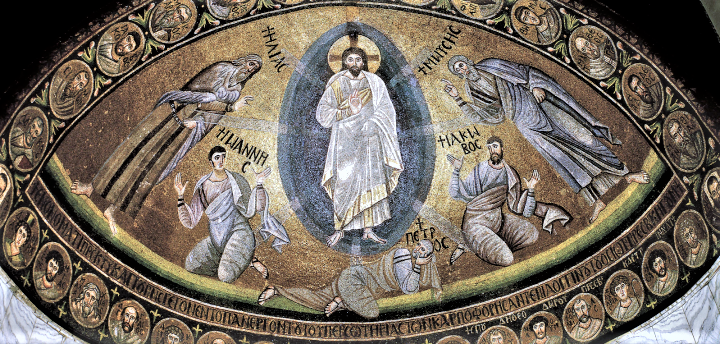
-The Transfiguration of Christ
-Byzantine
-Mosaic
-beginning of monasticism (monks), large groups became christian. lots of wealth for churches bc of tax exemption, deep blue mandorla (full body halo), jesus is flat and static
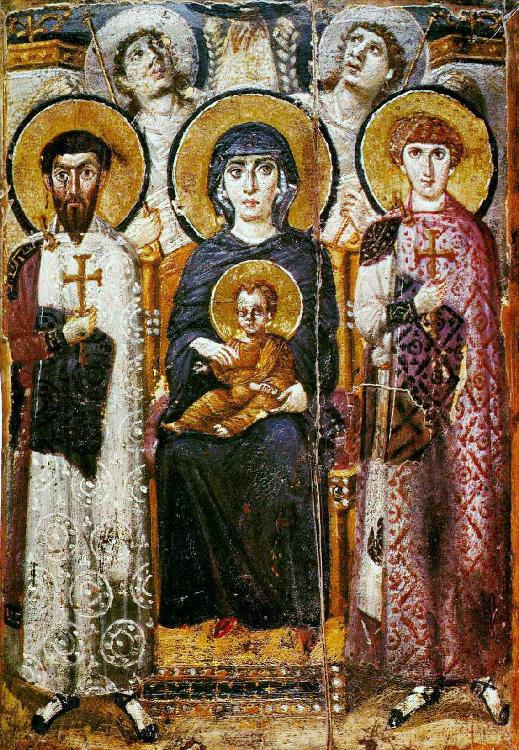
-Virgin and Child with Saints and Angels
-Byzantine
-encaustic on wood
-space, light, and color are huge for byzantine. Icons and idolatry is bad (unlike romans who thought themselves to be gods), no expression. STARRED
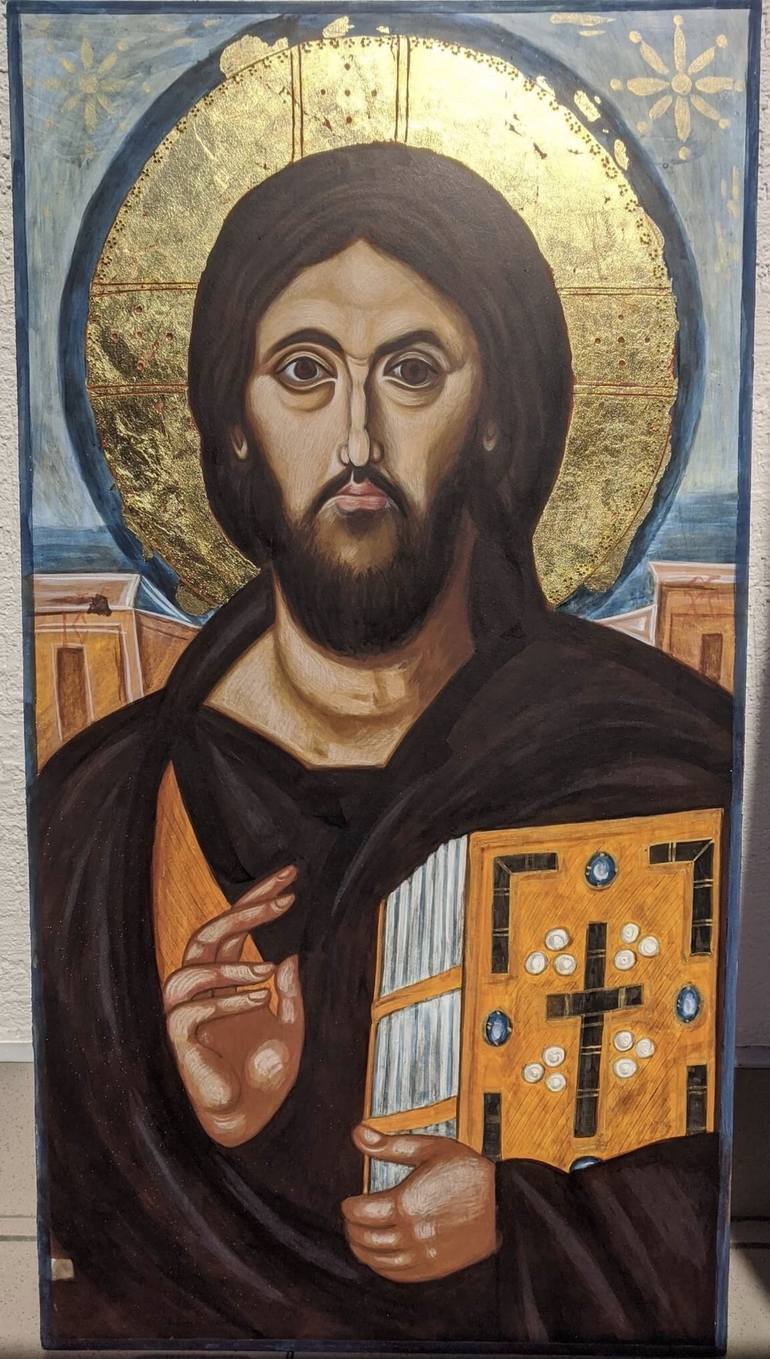
-Christ Blessing/Pantocrator
-Byzantine
-encaustic on wood
-2 sides of face, one more judging and the other accepting and who you see in the morning first is who you are for that day.
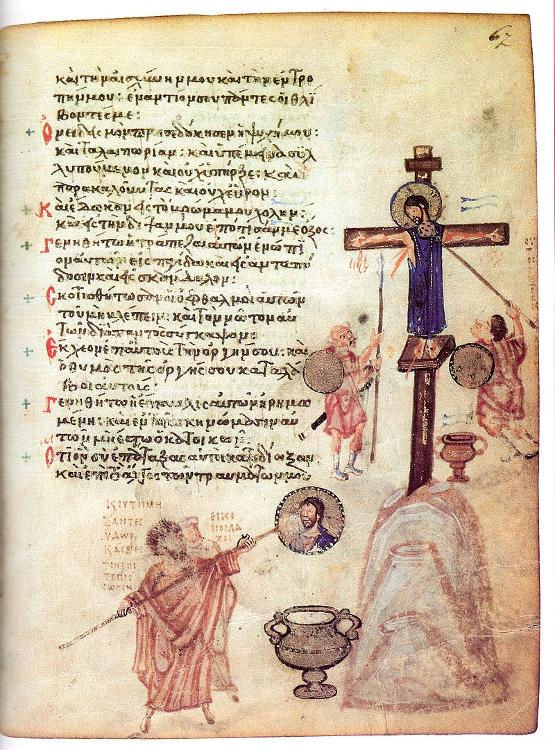
-Crucifixion and Iconoclasts (image breaking bc sacreligious)
-Byzantine
-temepera on vellum
-Emperor Leonardo started iconoclasm and persecuted artists bc: idolatry possibilities, anxiety about weakening empires, and monestaries

-Virgin and Child in the Apse of Hagia Sophia
-Byzantine
-mosaic
-Theotokos, after iconoclasm, seated on platform and bench
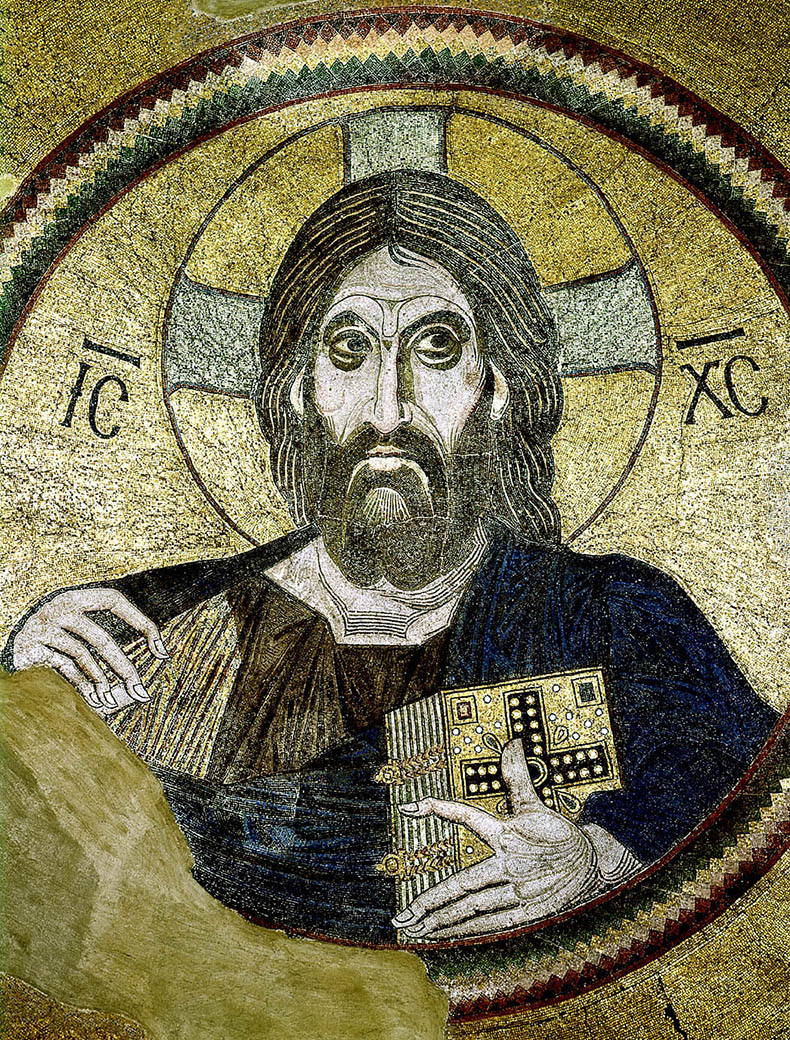
-Christ Pantokrator with Scenes from the Life of Christ
-Byzantine
-mosaic
-gold, squinches, judgey--christ comes back to judge souls, unkind
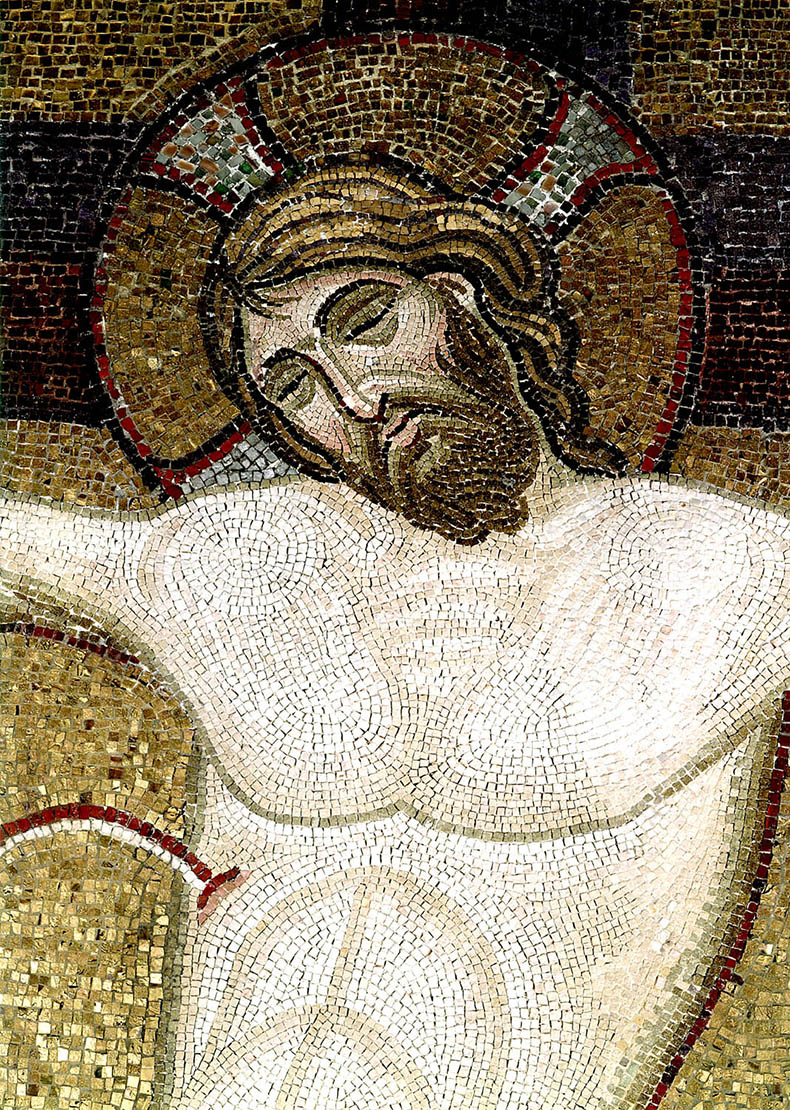
-Crucifixion
-Byzantine
-mosaic
-emotional appeal, sacraficing life for humanity, gold back, rocks and skull to represent adam's burial (connection of new testament. christ feels human pain)
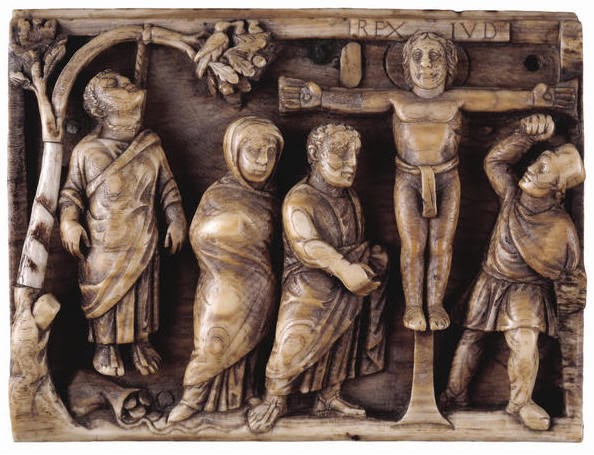
-Suicide of Judas and Crucifixion of Christ
-Byzantine
-Ivory
-no pain, reconnects with heavenly plane, judas feels guilt and commits suicide
...
-David composing the Psalms
-Byzantine
-paint and gold on vellum
-Virgin of Vladimir
-Byzantine
-tempera on panel
-compassion, jesus is unearthly, russian icon
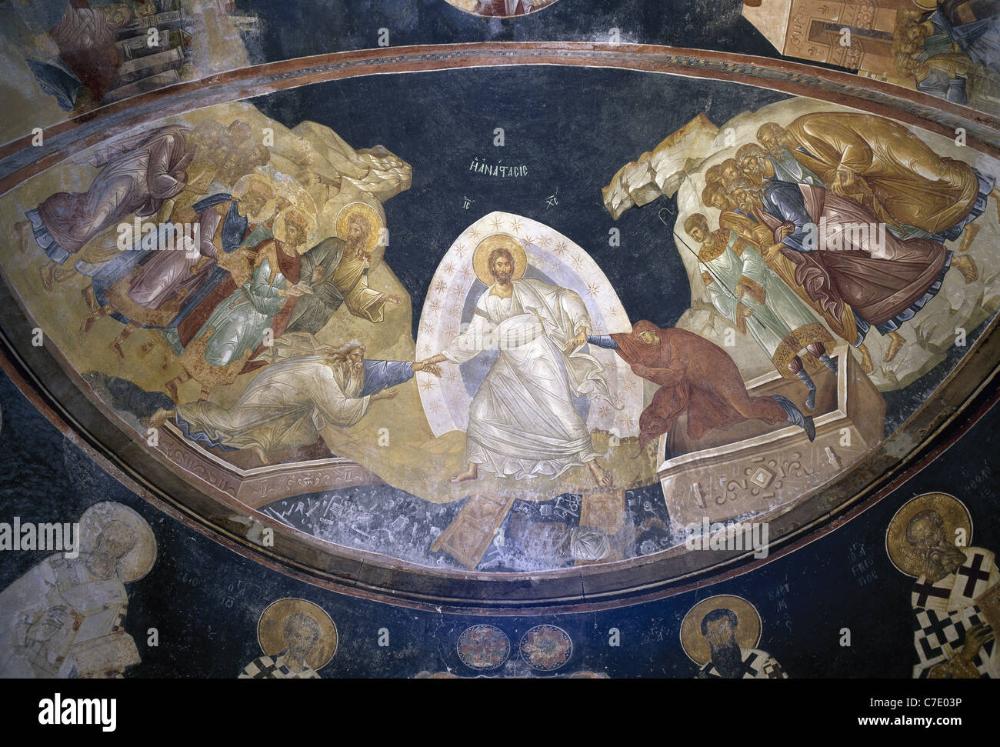
-Anastasis
-Byzantine
-fresco
-Jesus with mandorla demonstrating power of salvation. prophets witnessing a miracle

-The Hospitality of Abraham by Andrey Rublev
-Byzantine
-tempera on panel
-Russia icon, Abraham and wife Sarah entertaining God in 3 human forms

-The Kaaba
-Islamic Art
-stone
-originally for polytheism but the dominant religion (Islam) took over the space and modified its purpose. Walk in circle around it, pilgrimage if Muslims can afford to go once in their life
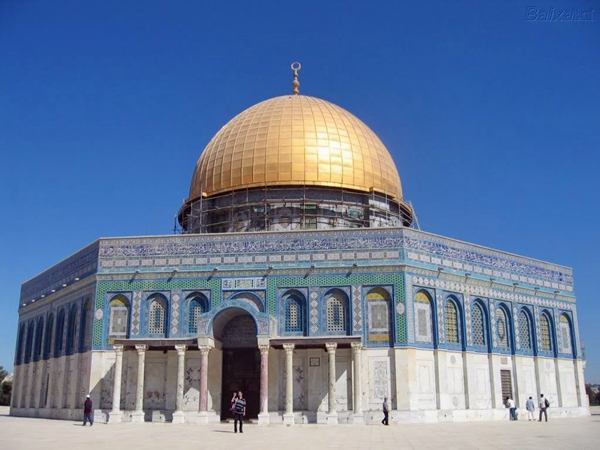
-Dome of the Rock
-Islamic
-wood, stone, architecture
-Soloman, creation of Adam and where Abraham was prepared to sacrifice his son, Muhammad's ascension was here
-octagonal mosaics, abstract but symmetrical patterns, rounded arches that have pointed tops with lots of Qur'anic texts
What are the different parts of a mosque and their function?
-Qibia Wall: faces Kabba, has a nook for the mihrab
-Mihrab: where the Qur'an is kept
-Minbar: Imam climbs the steps of this raised platform so his prayers can be heard
-Minaret: tower where the call to prayer takes place

-The Great Mosque
-Islamic
-originally christian church but was used by romans before, pediment on top

-Mosaic from the Courtyard of The Great Mosque
-Islamic
-Mosaic, glass tessera
-abstract, gold for spirituality

-Dome in front of the Mihrab, The Great Mosque
-Islamic
-in cordoba which was a huge commercial and intellectual hub and catered to the arts. Inscriptions and geometric motifs, stylized vegetation
-Page from the Qur'an
-Islamic
-black ink pigments and gold on vellum
-calligraphy and writing is considered to be the highest art form in Islam, calligraphers are some of the highest regarded member of society at the time
-Plate with Kufic Border
-Islamic
-ceramic
-writing says "knowledge, the beginning is bitter to taste, the end is sweet like honey

-The Mosaic Mihrab
-Islamic
-glazed and cut tiles
-mongols terrorized Iran, but also artist exchanged ideas. Domes, rhythmically repeated elements, bright colors and contrast with colors, floral patterns in reference to paradise
What are the three types of arches
-rounded
-keel
-pointed

-Muhammad Ibn al-Zain, Baptistery of St. Loius
-Islamic
-brass inlaid with silver and gold
-royal events depicted. defeating mongols, animals to symbolize might and power, used to baptise royal babies
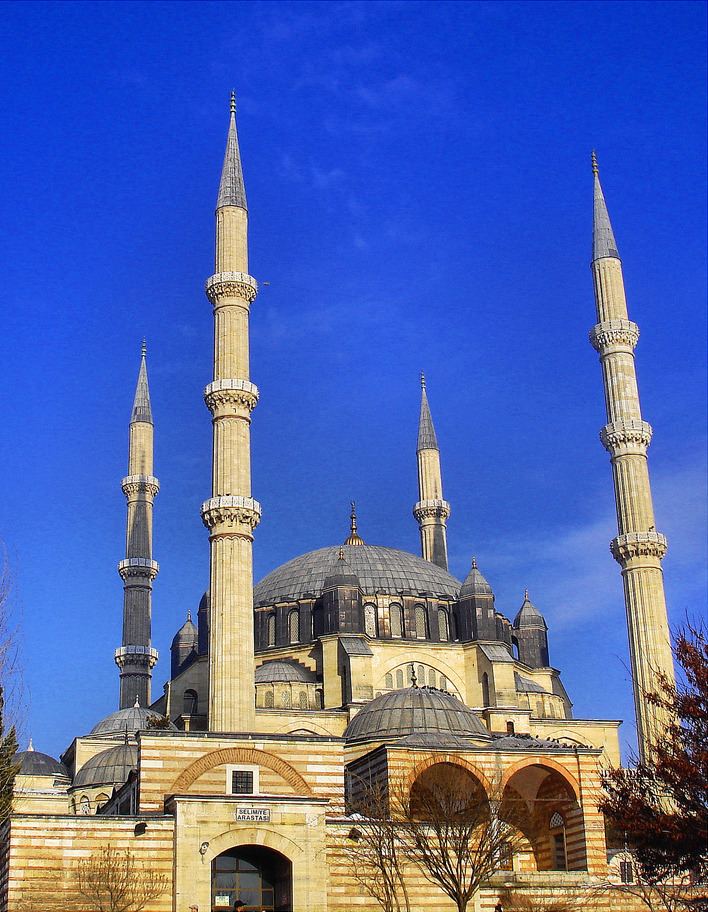
-Mosque of Sultan Selim, Sinan
-Islamic
-goal was to create a dome larger than Hagia Sophia, 4 minarets for symmetry, not red unlike Hagia Sophia, buttressing, marketplaces, and squinches
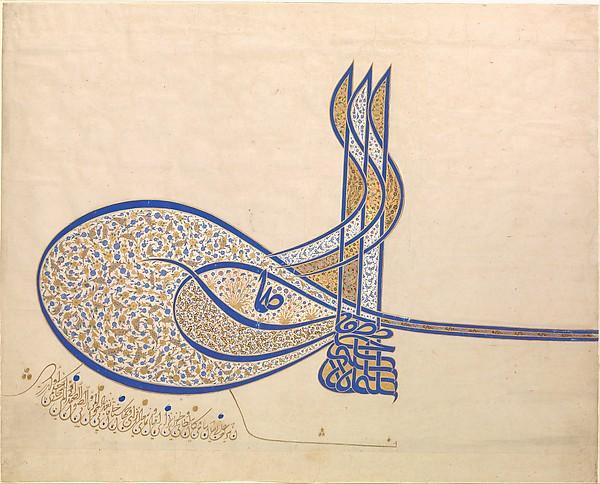
-Illuminated Tuguru of Sultan Suleyman
-Islamic
-ink, paint, and gold on paper
-manuscript with images to help with spiritual enlightenment, used on seals, coins, or official documents. abstract floral patterning
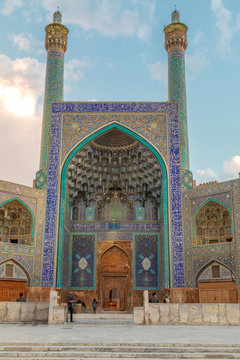
-Masjid I-Shah, Isfahan
-Islamic
-Timirid architecture
-onion dome, 4 ewon planes for teaching, keel arch, pattern, rhythm and repetition